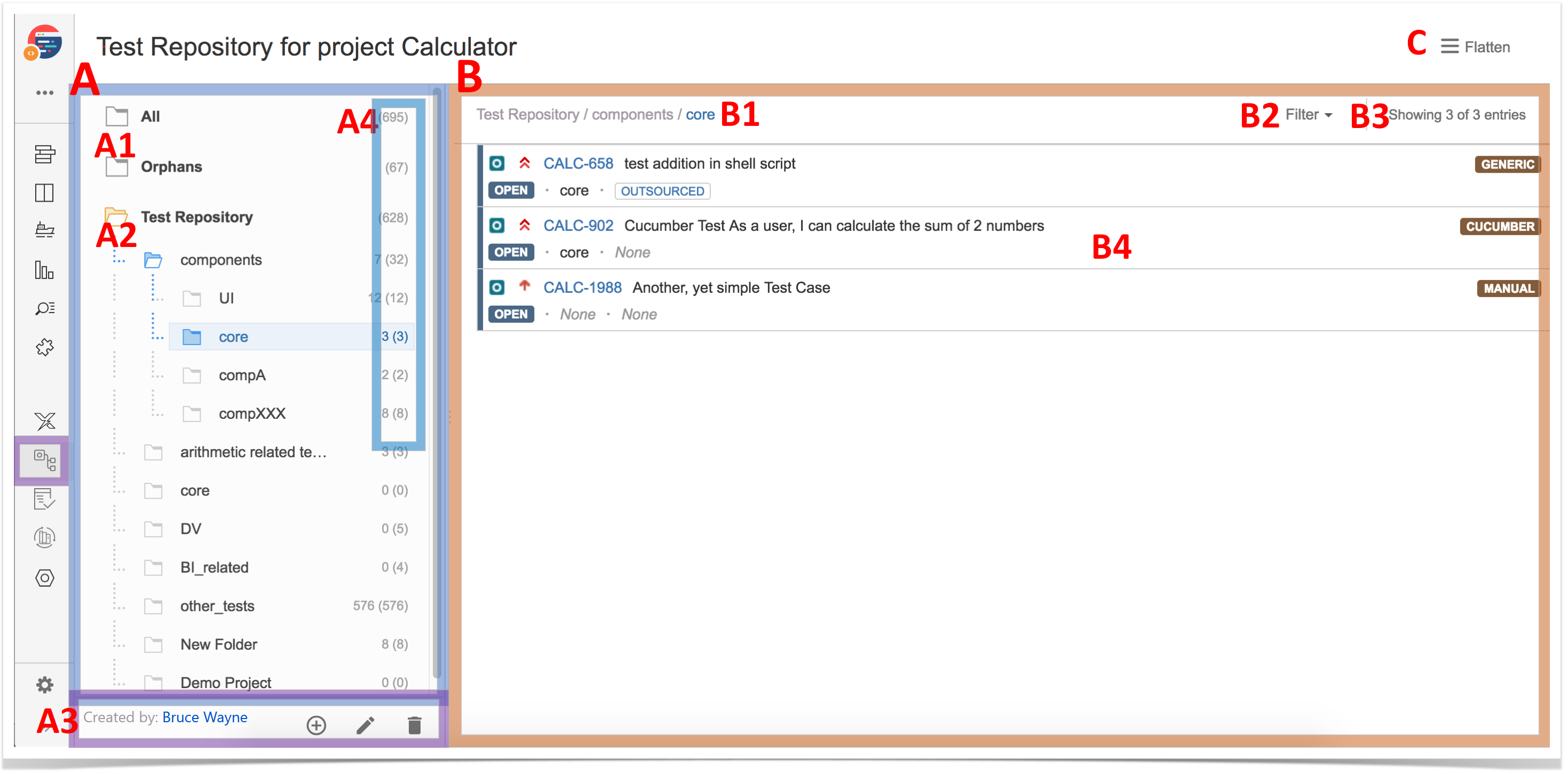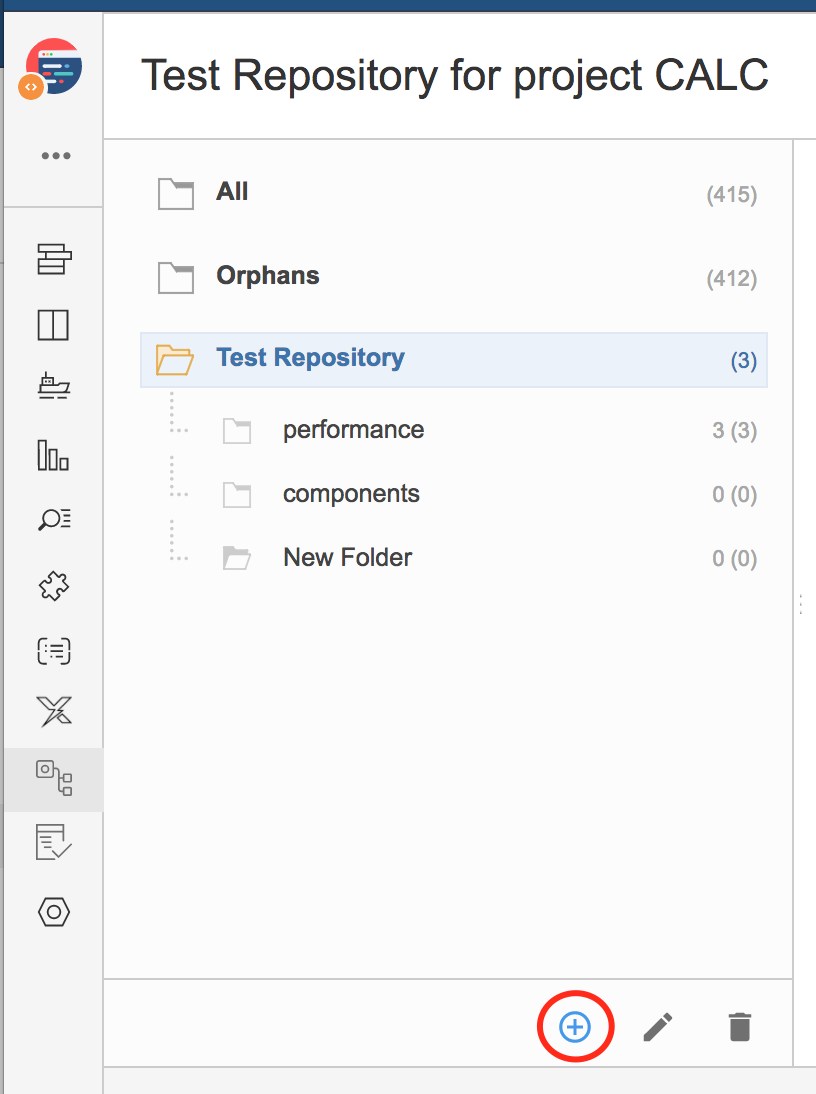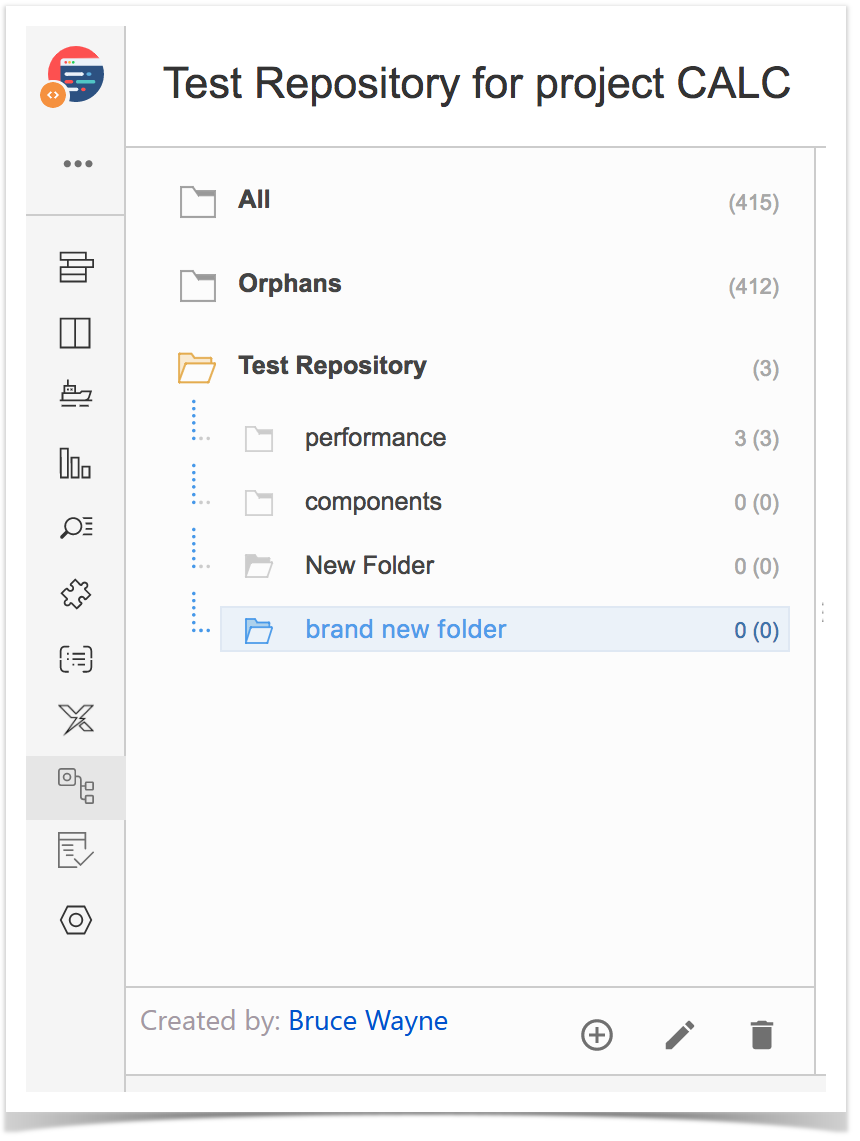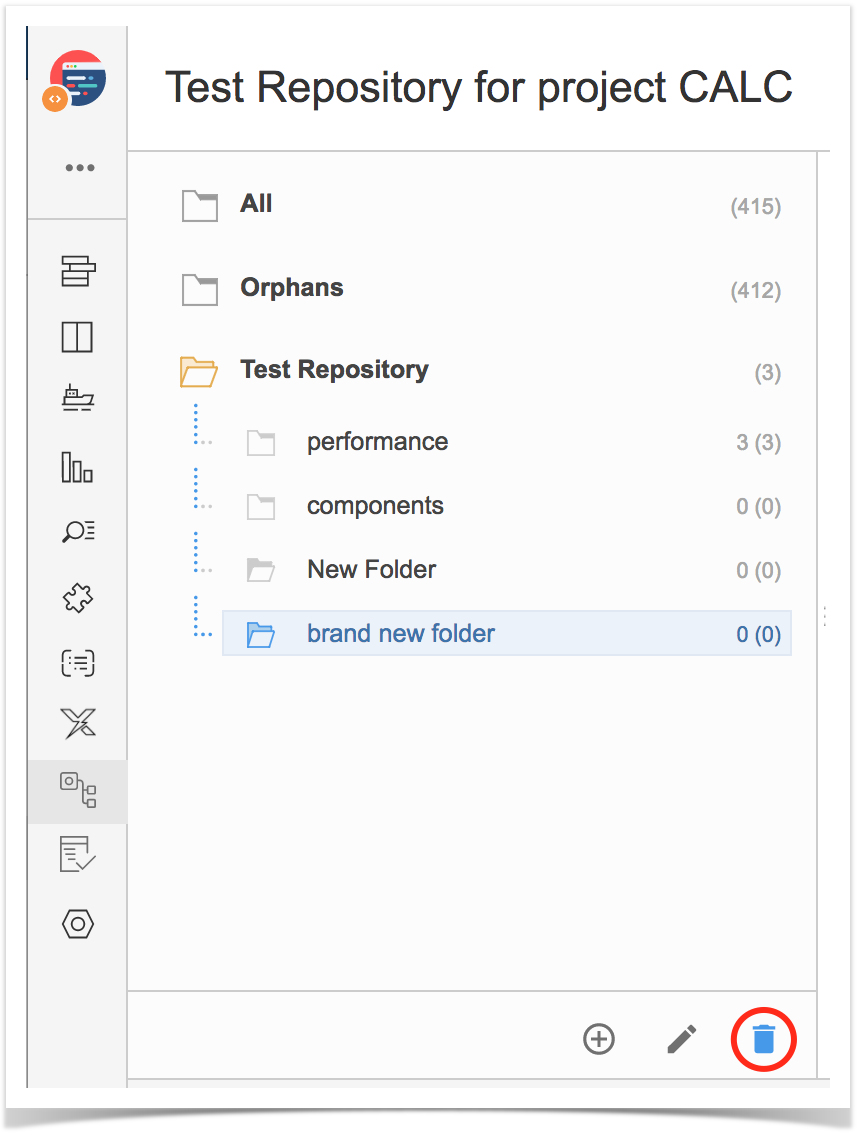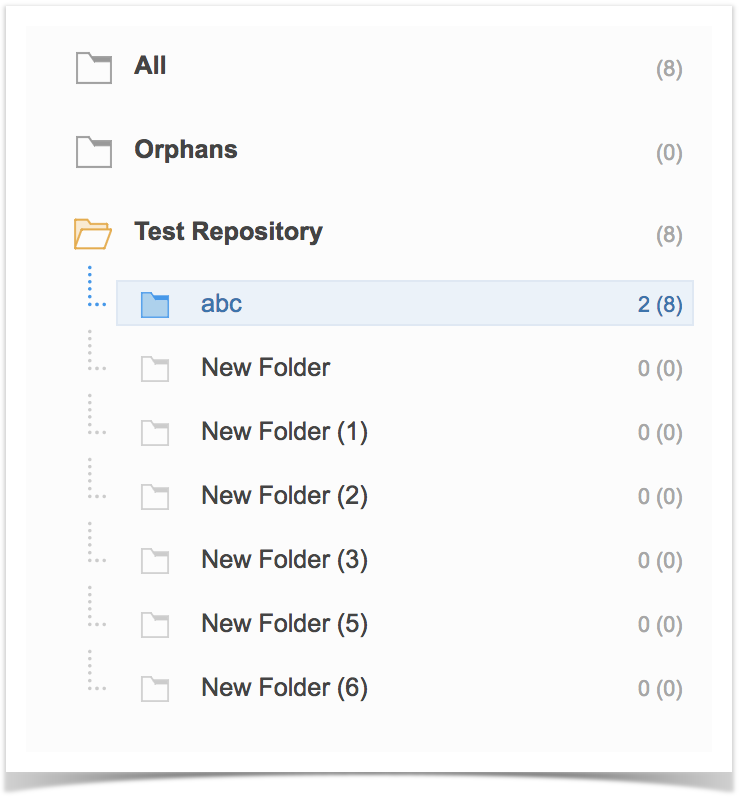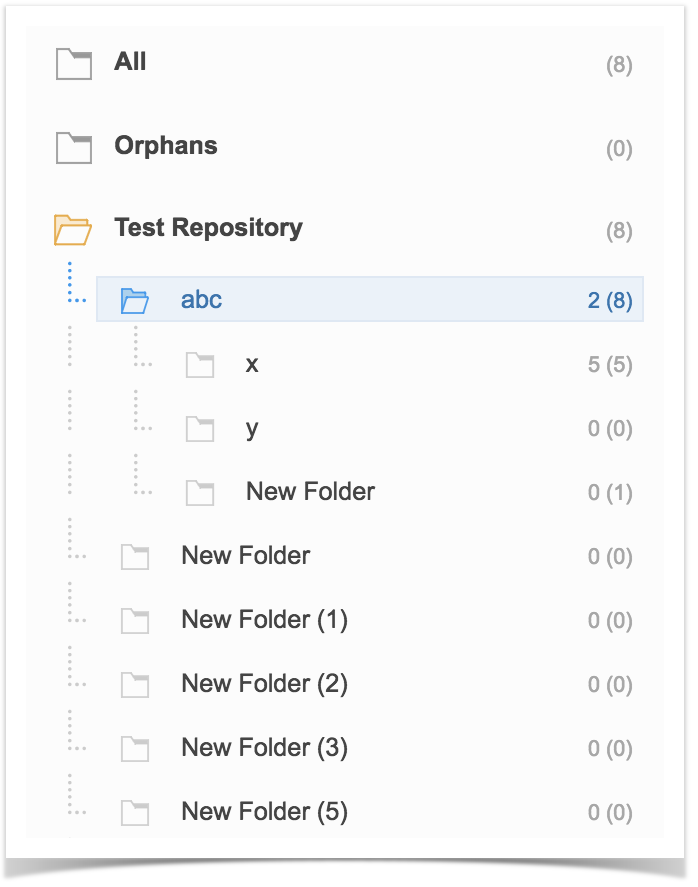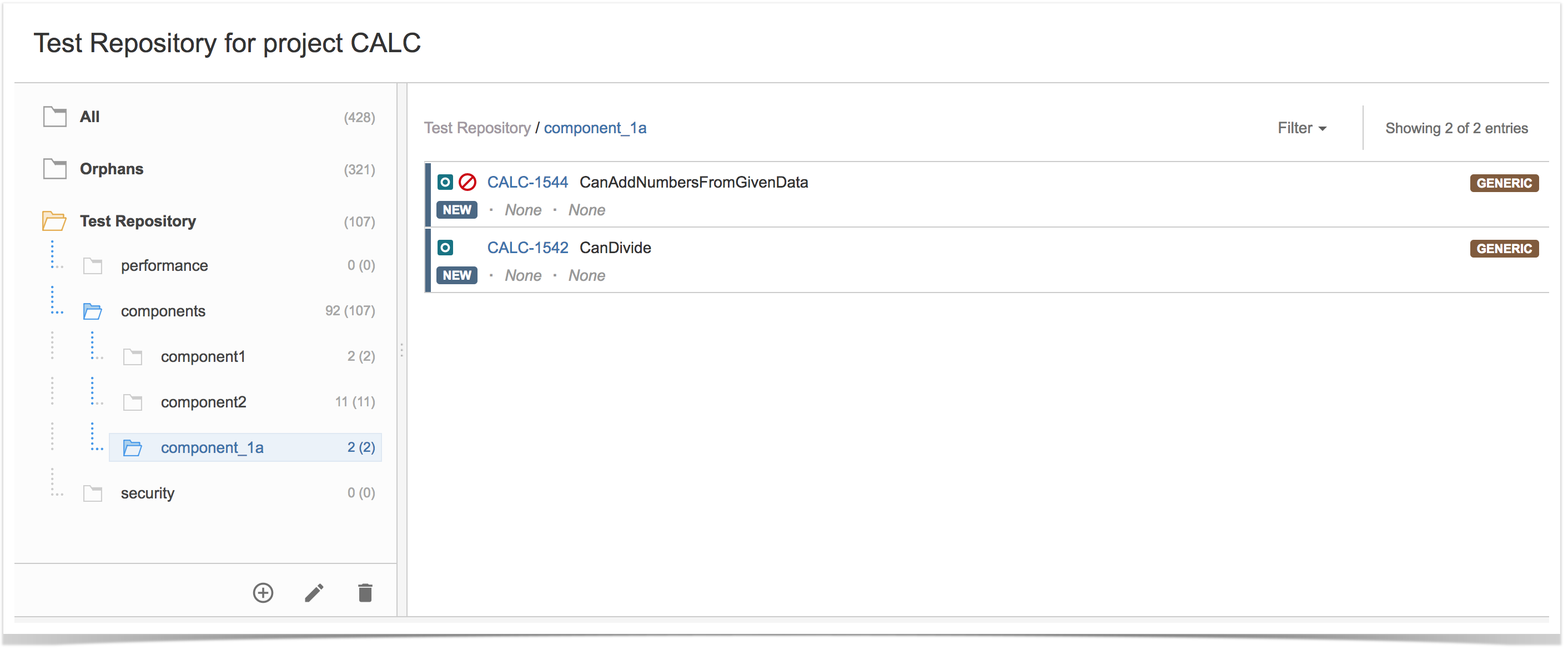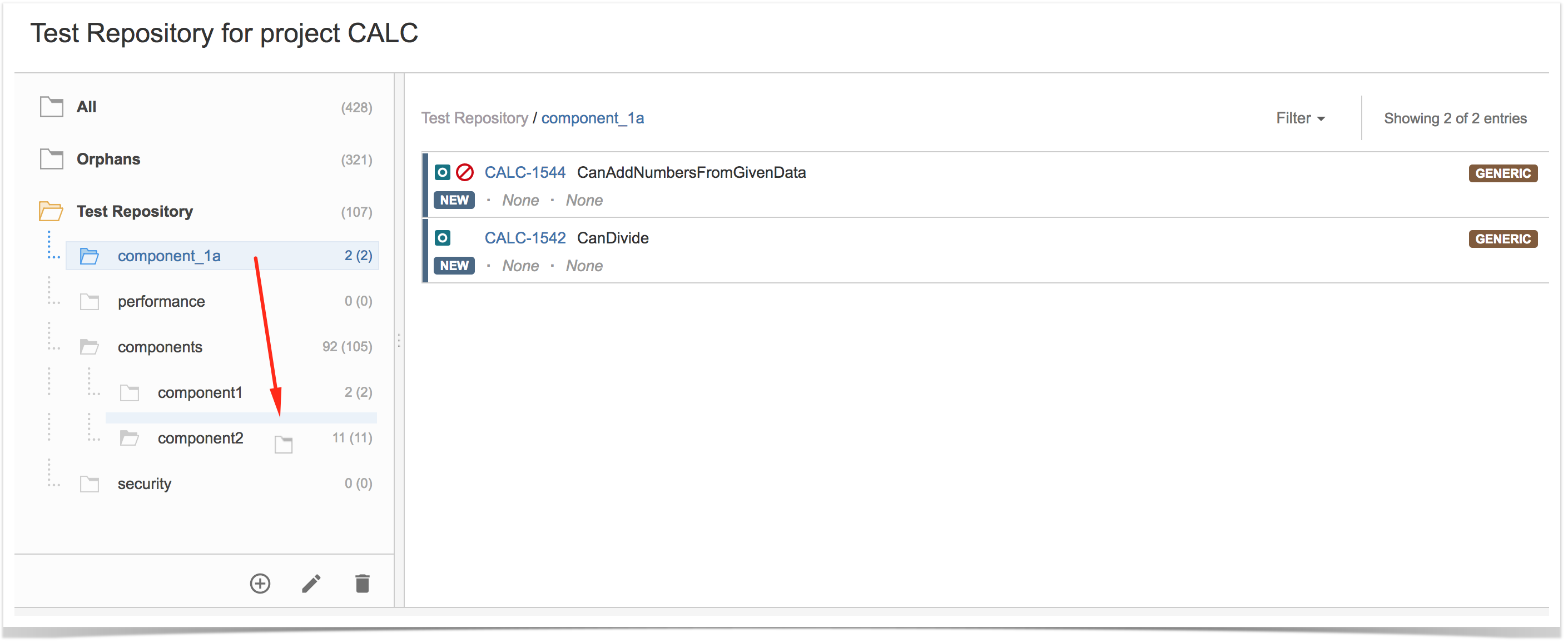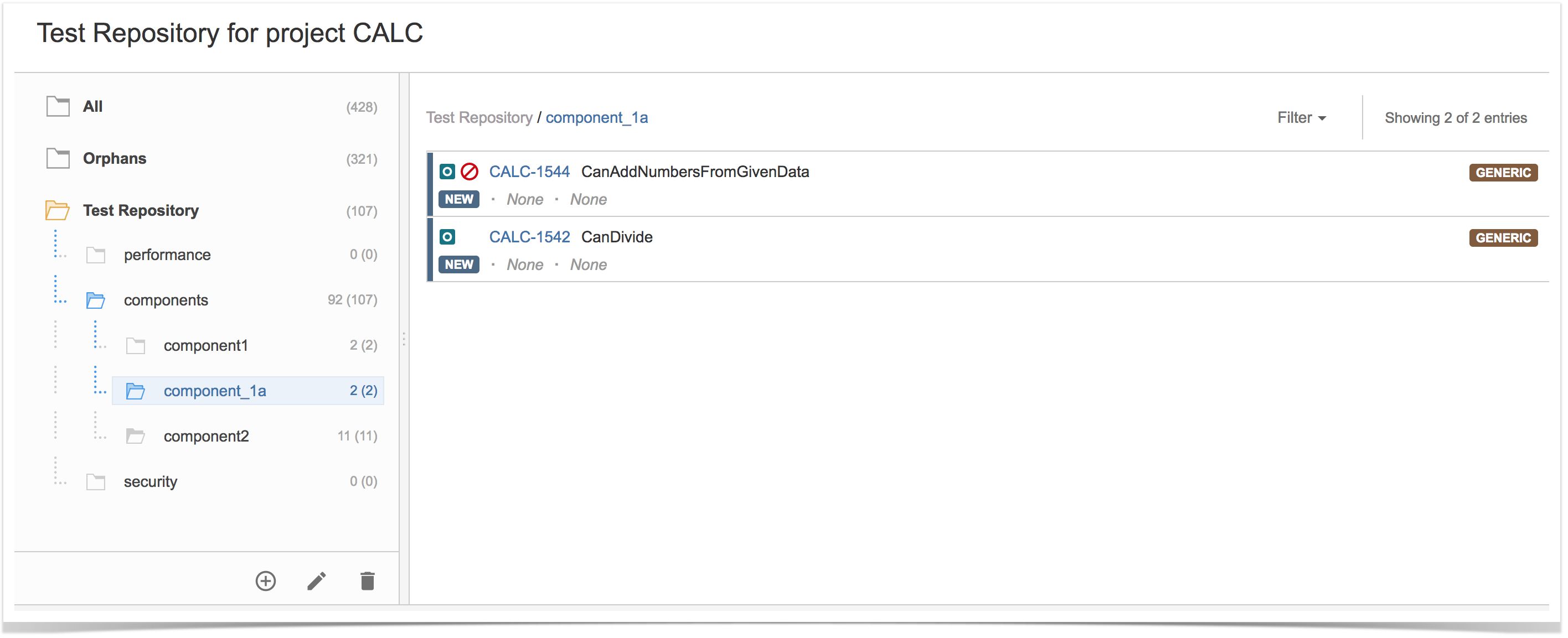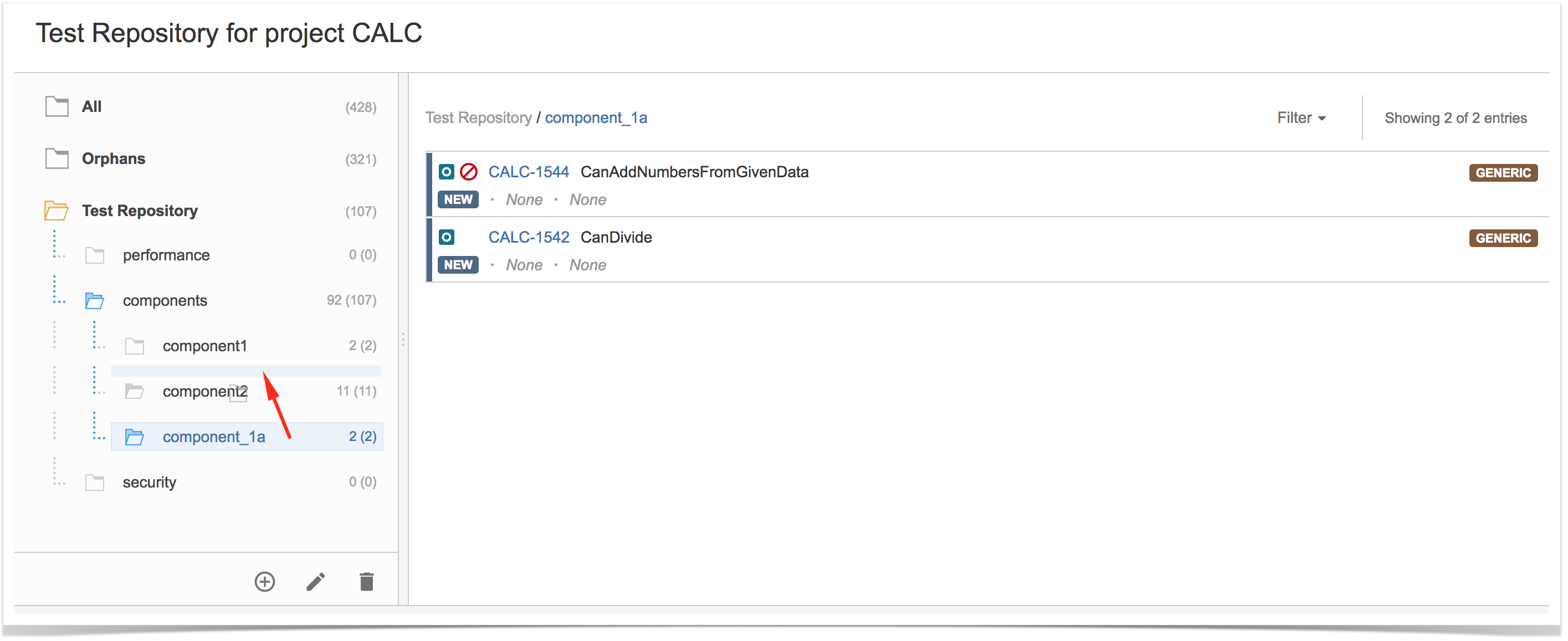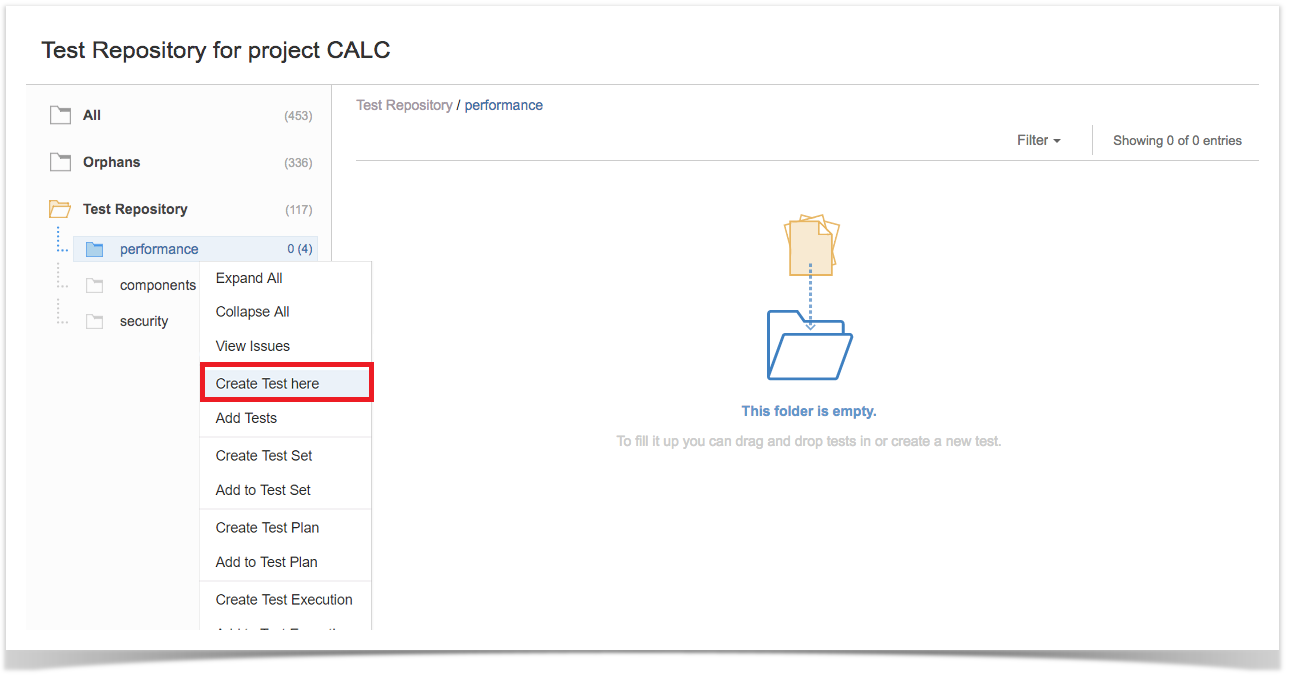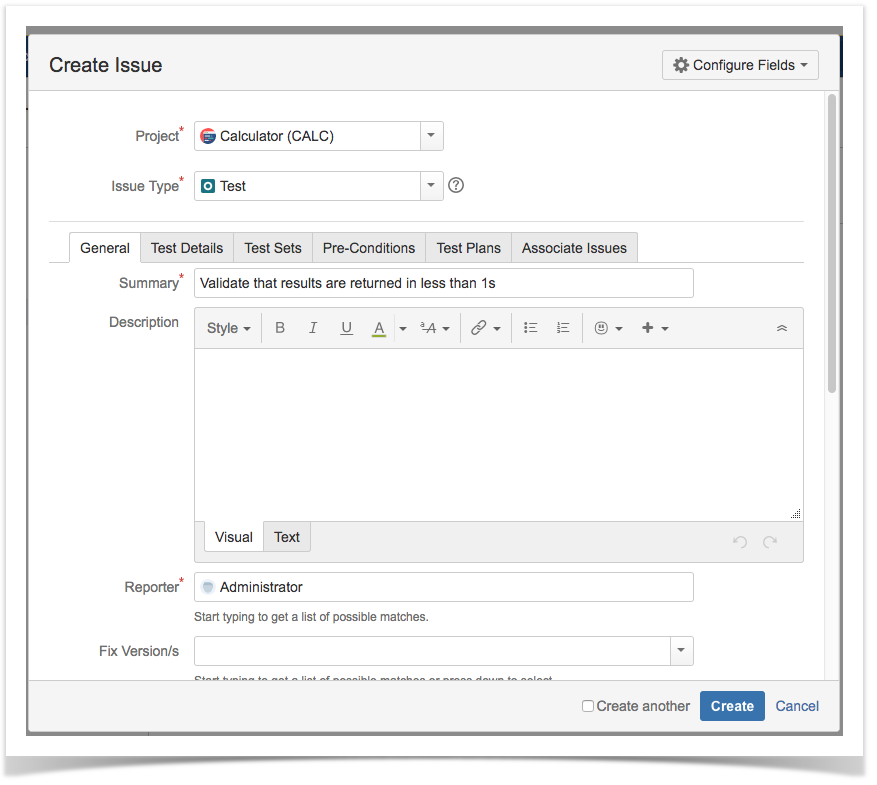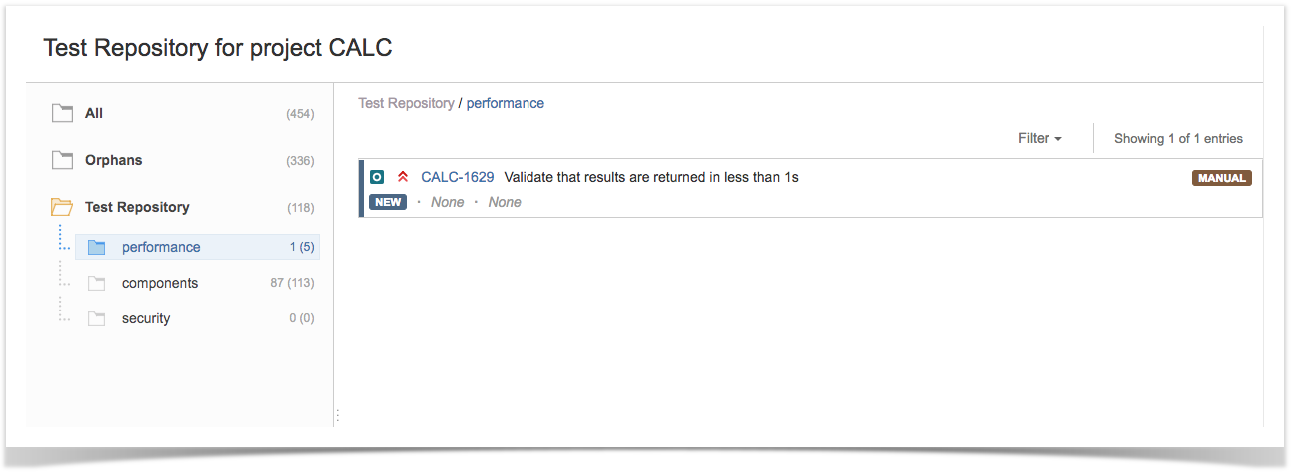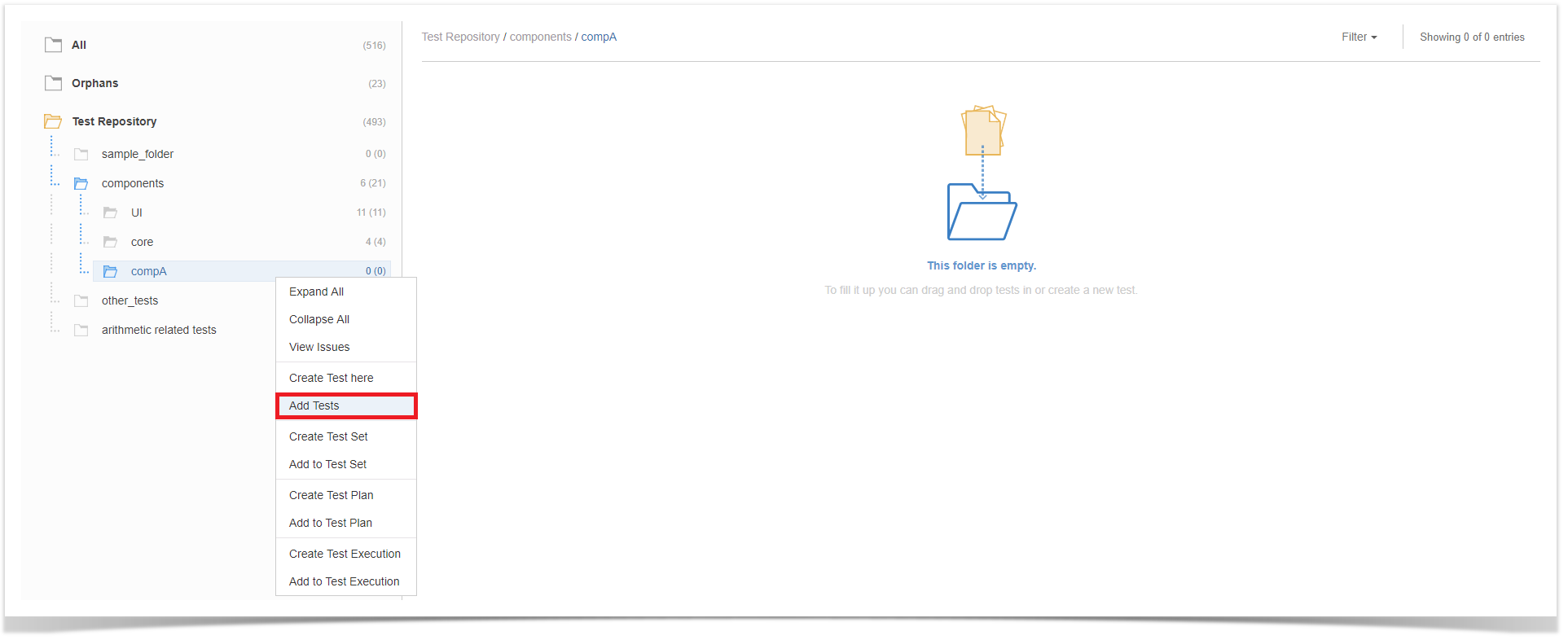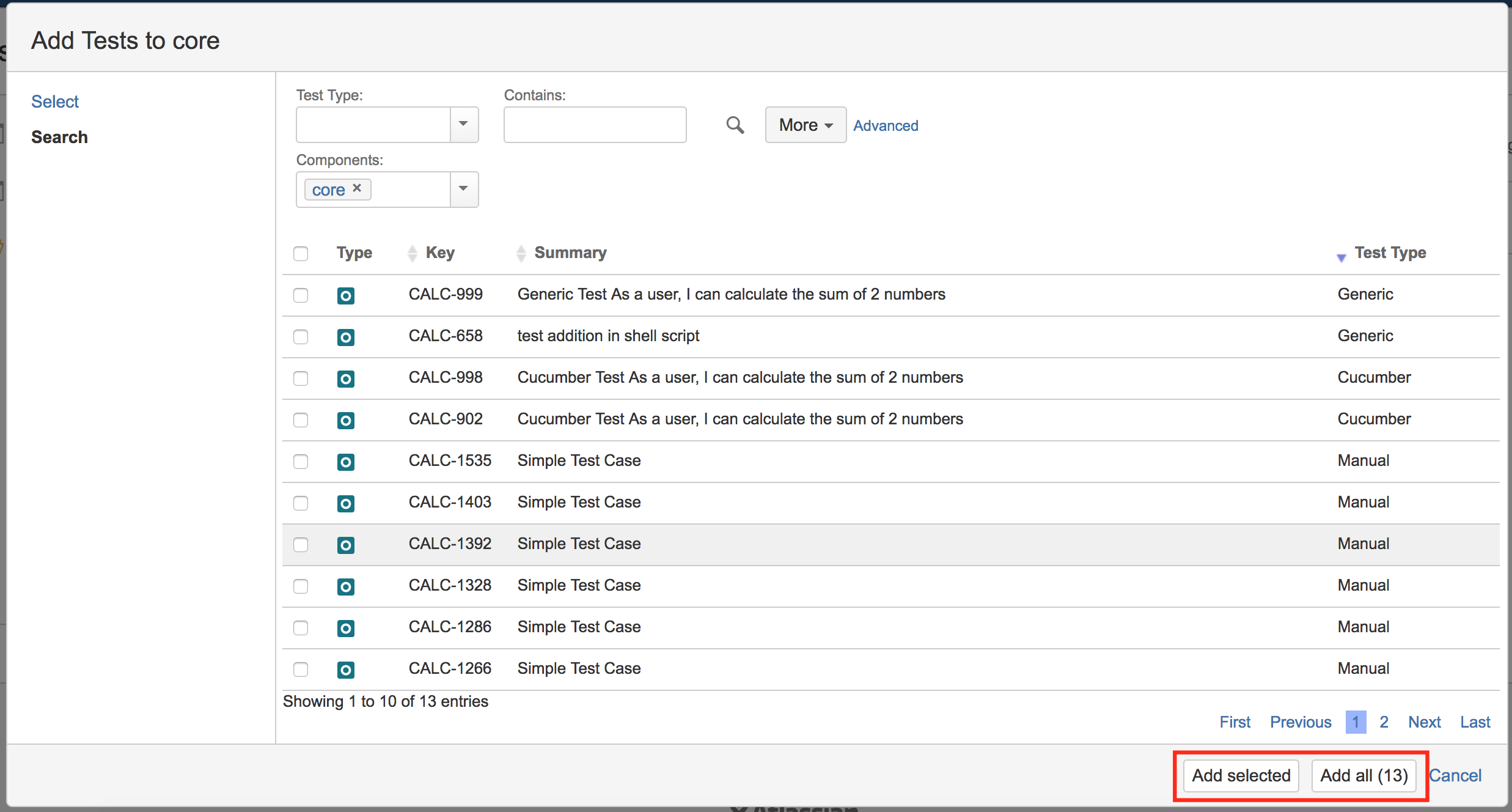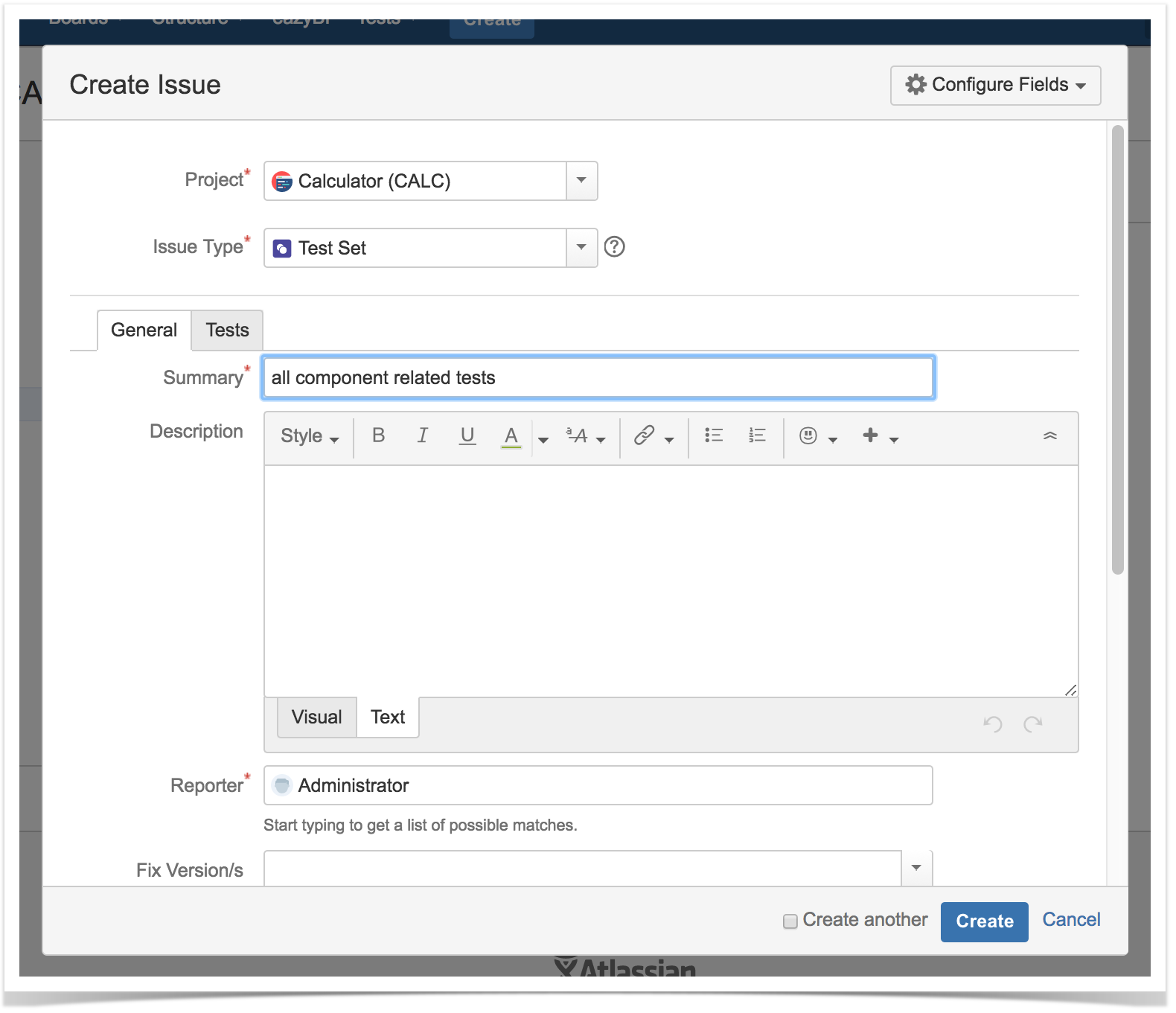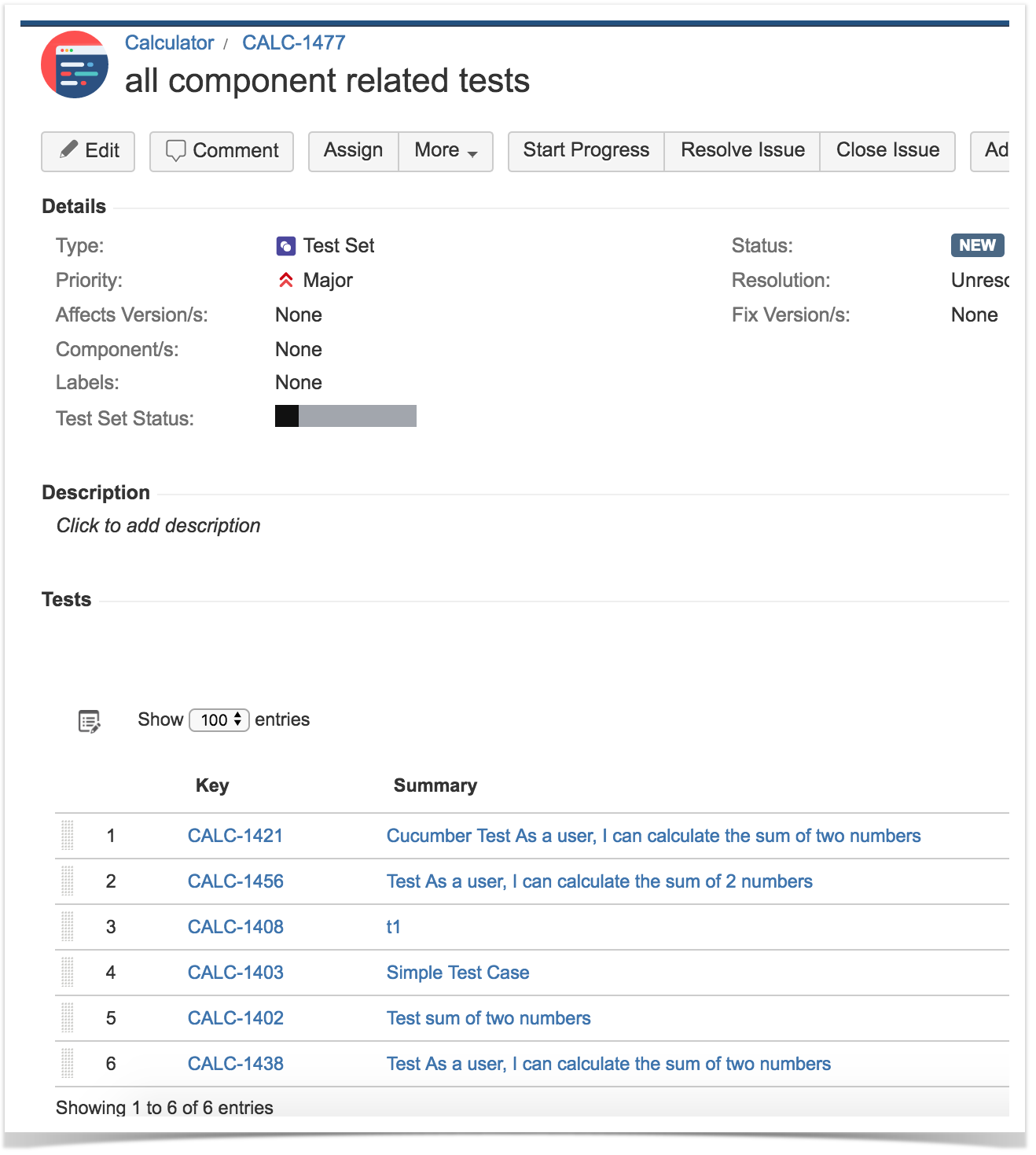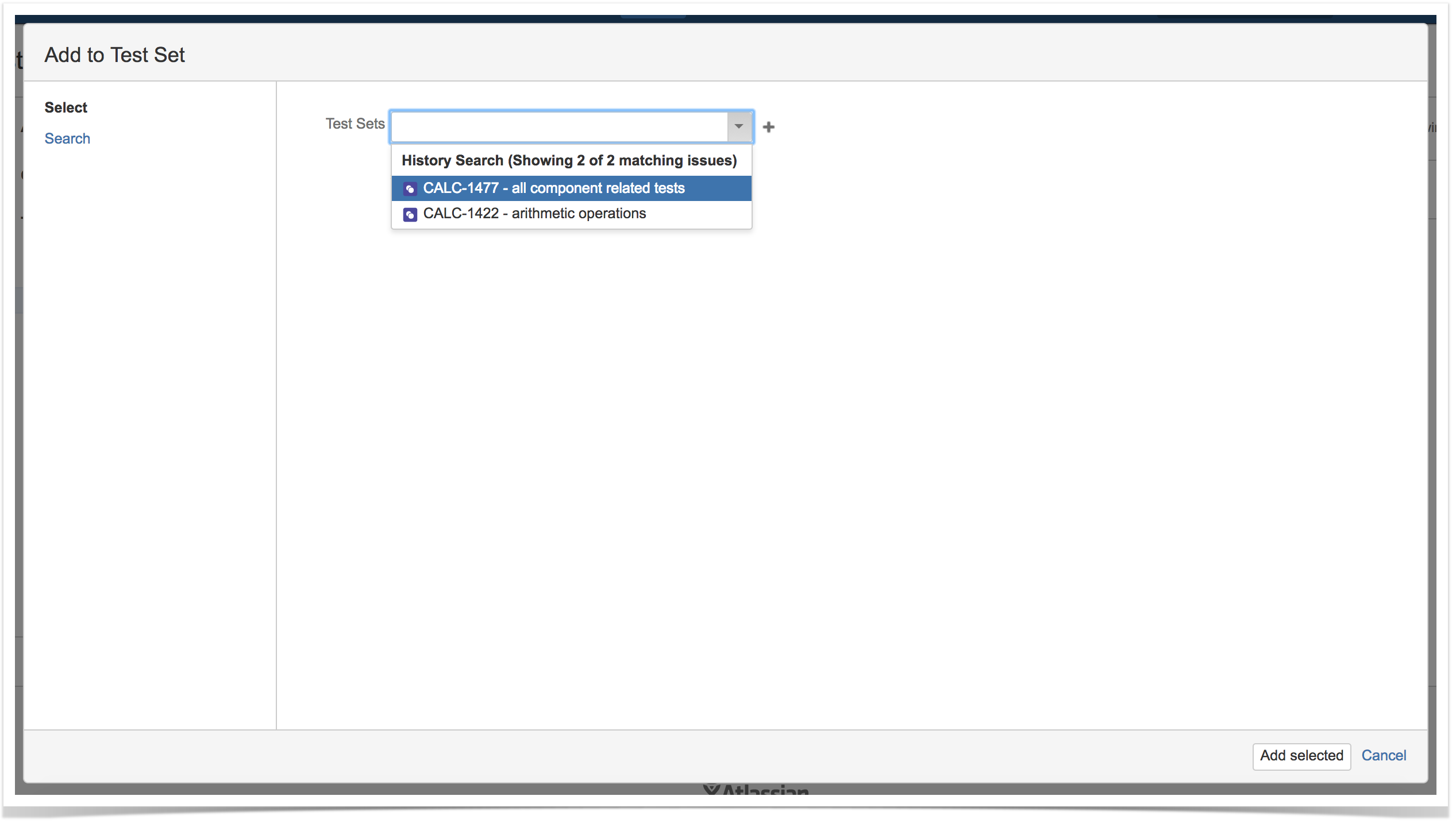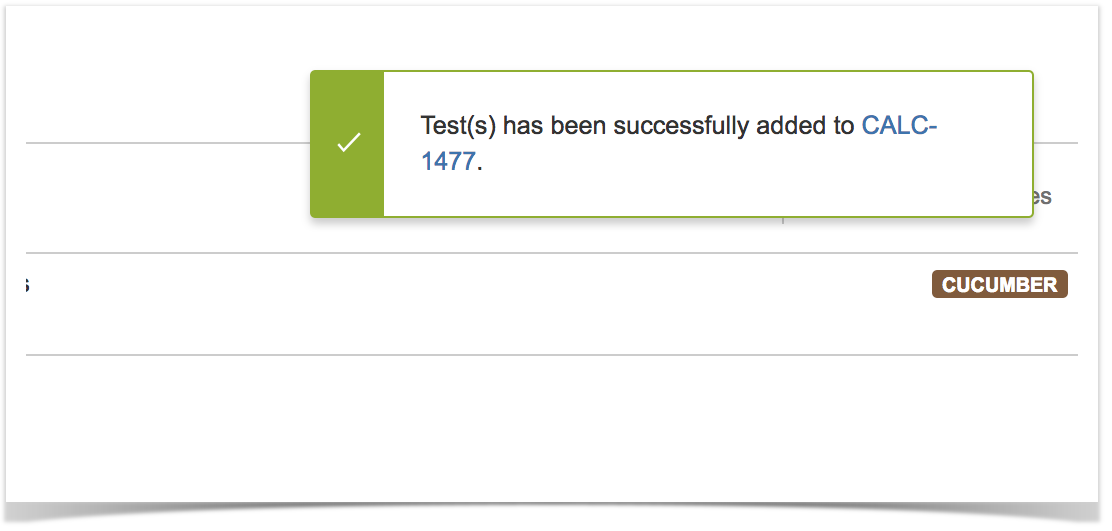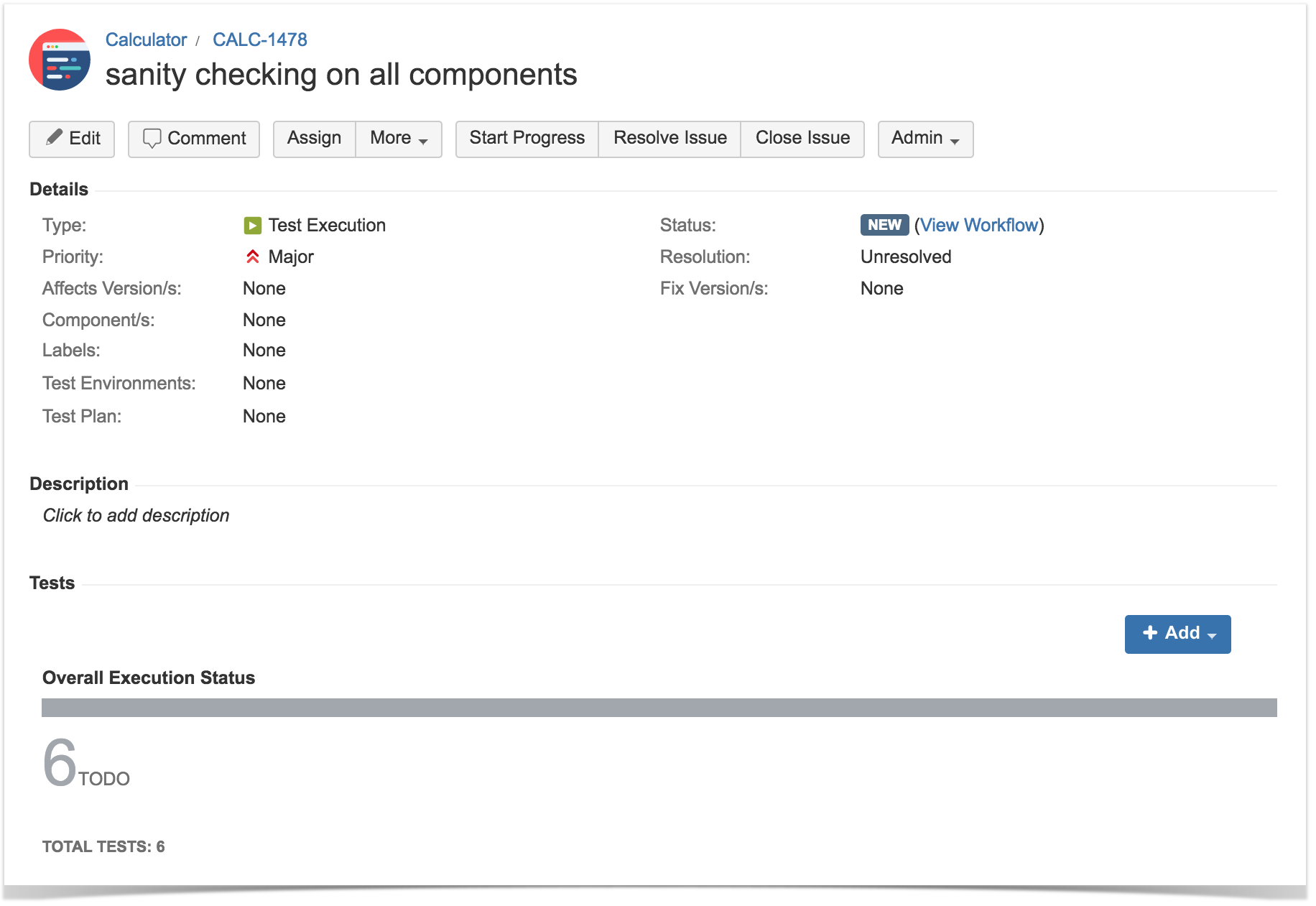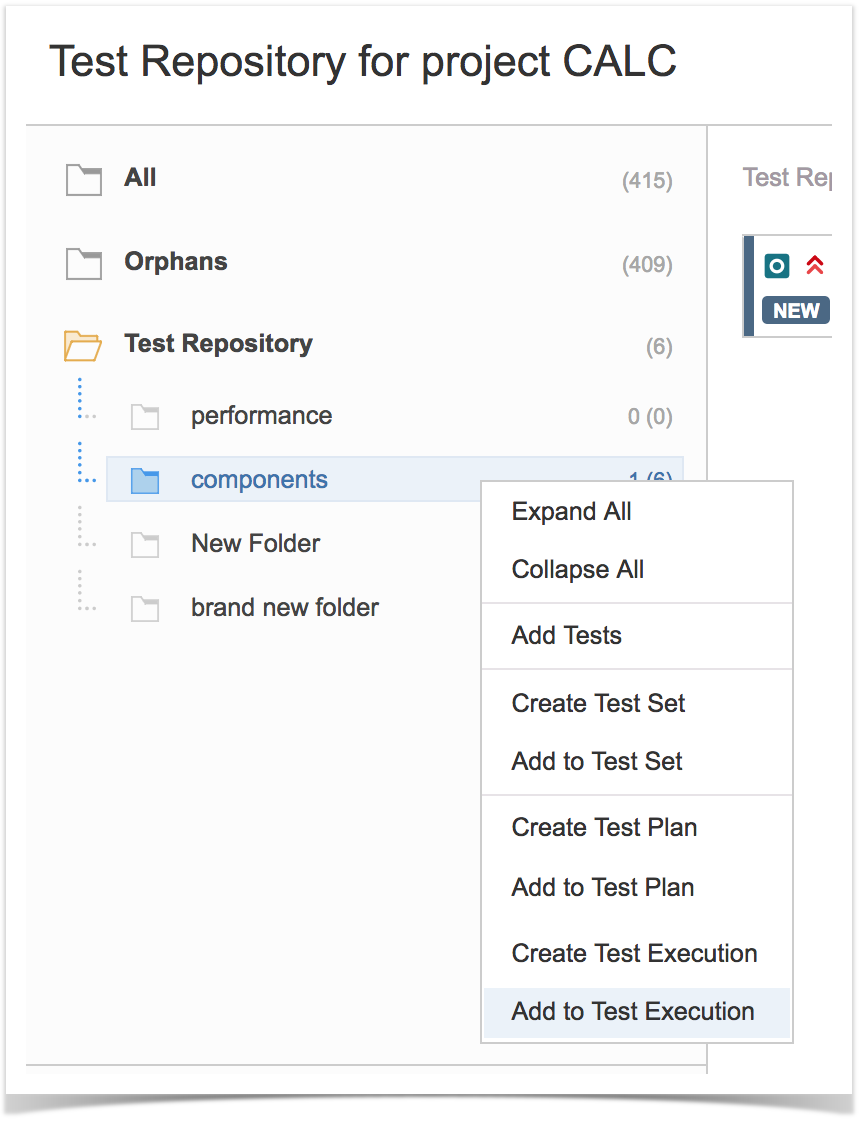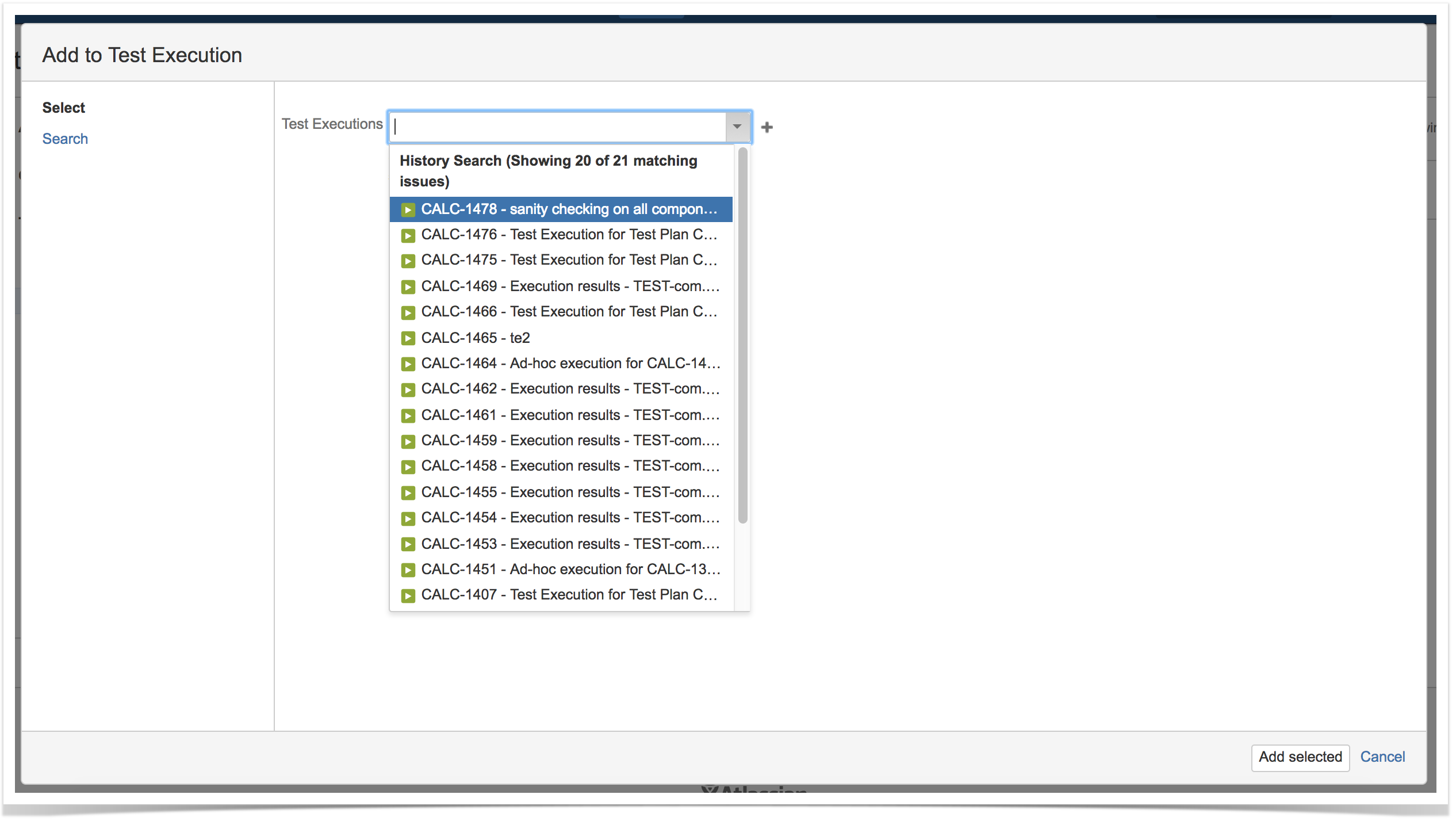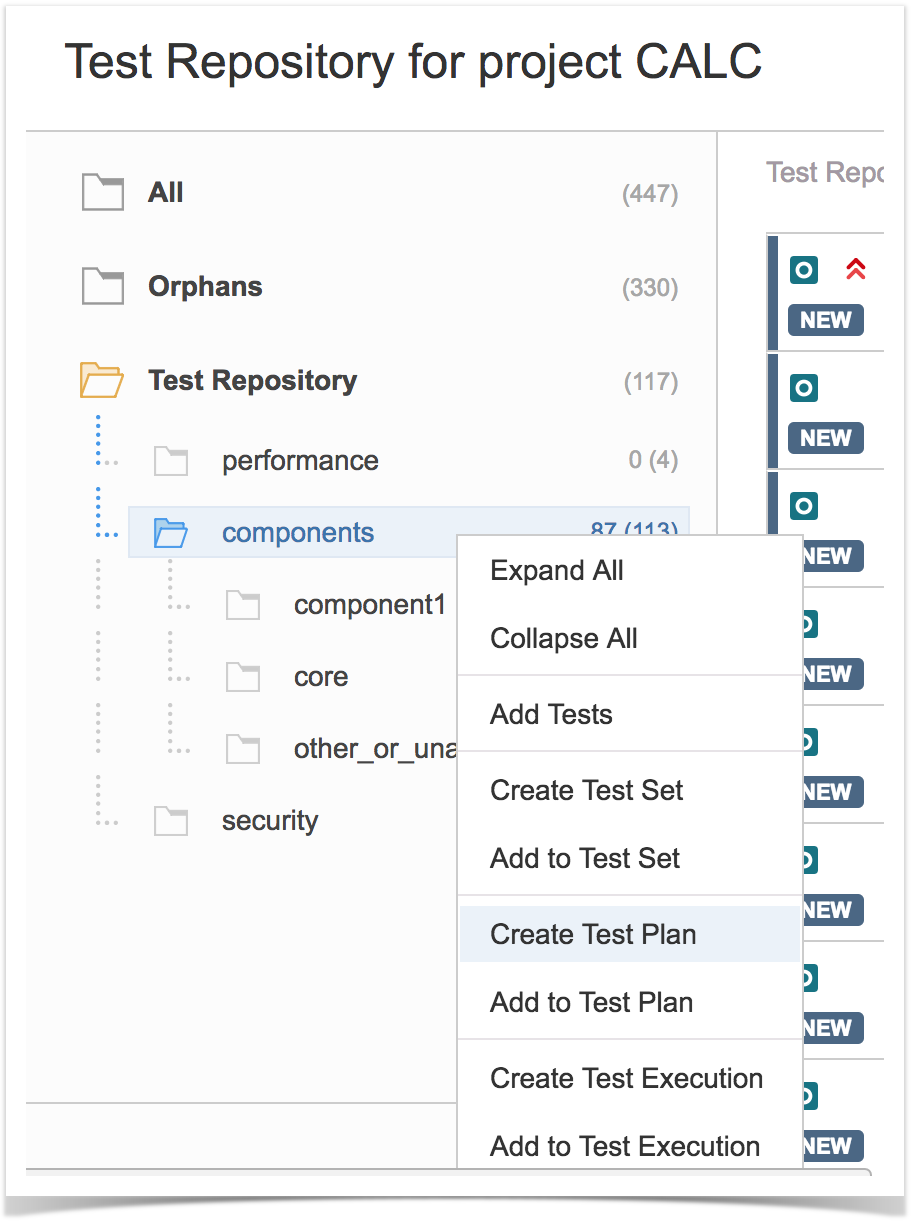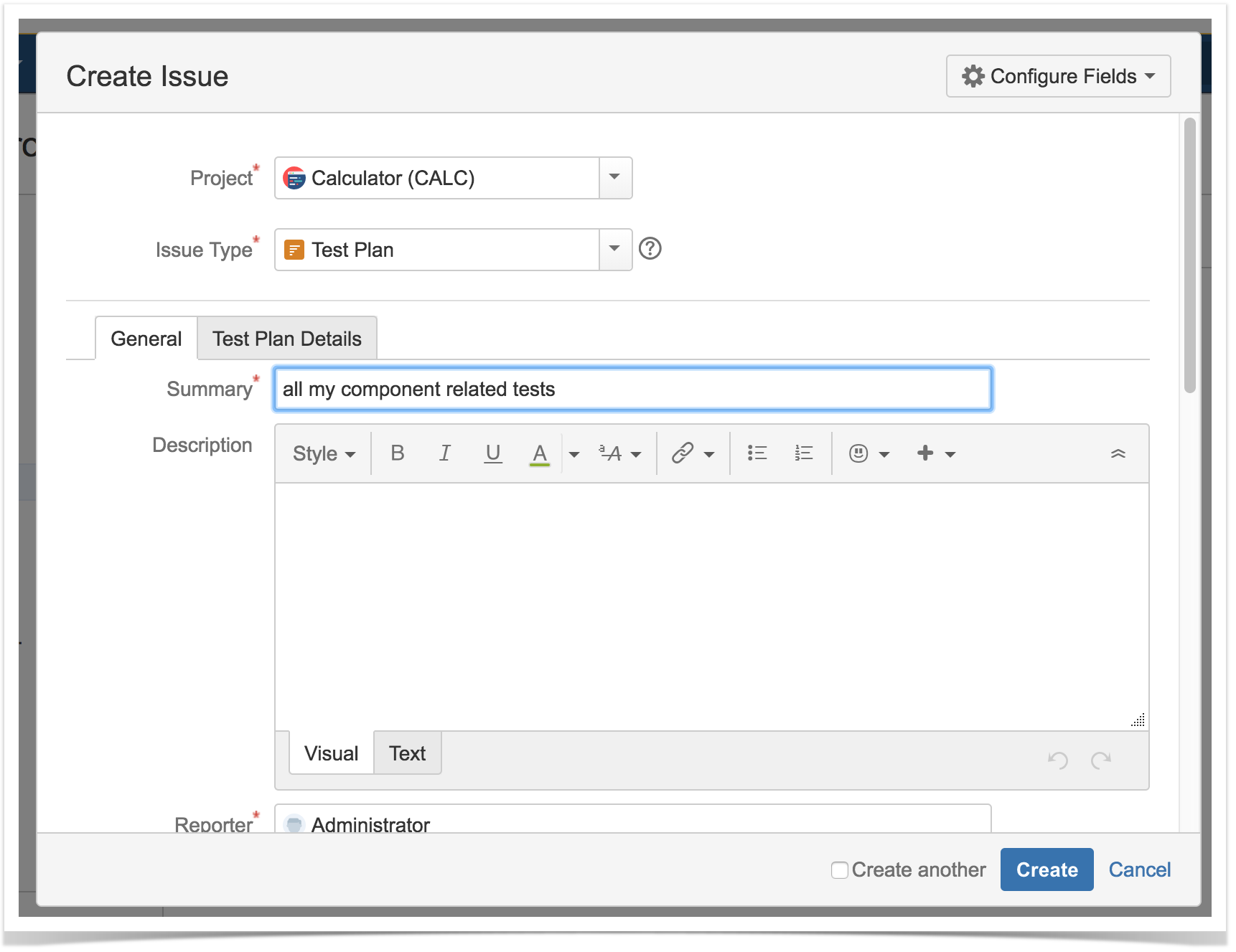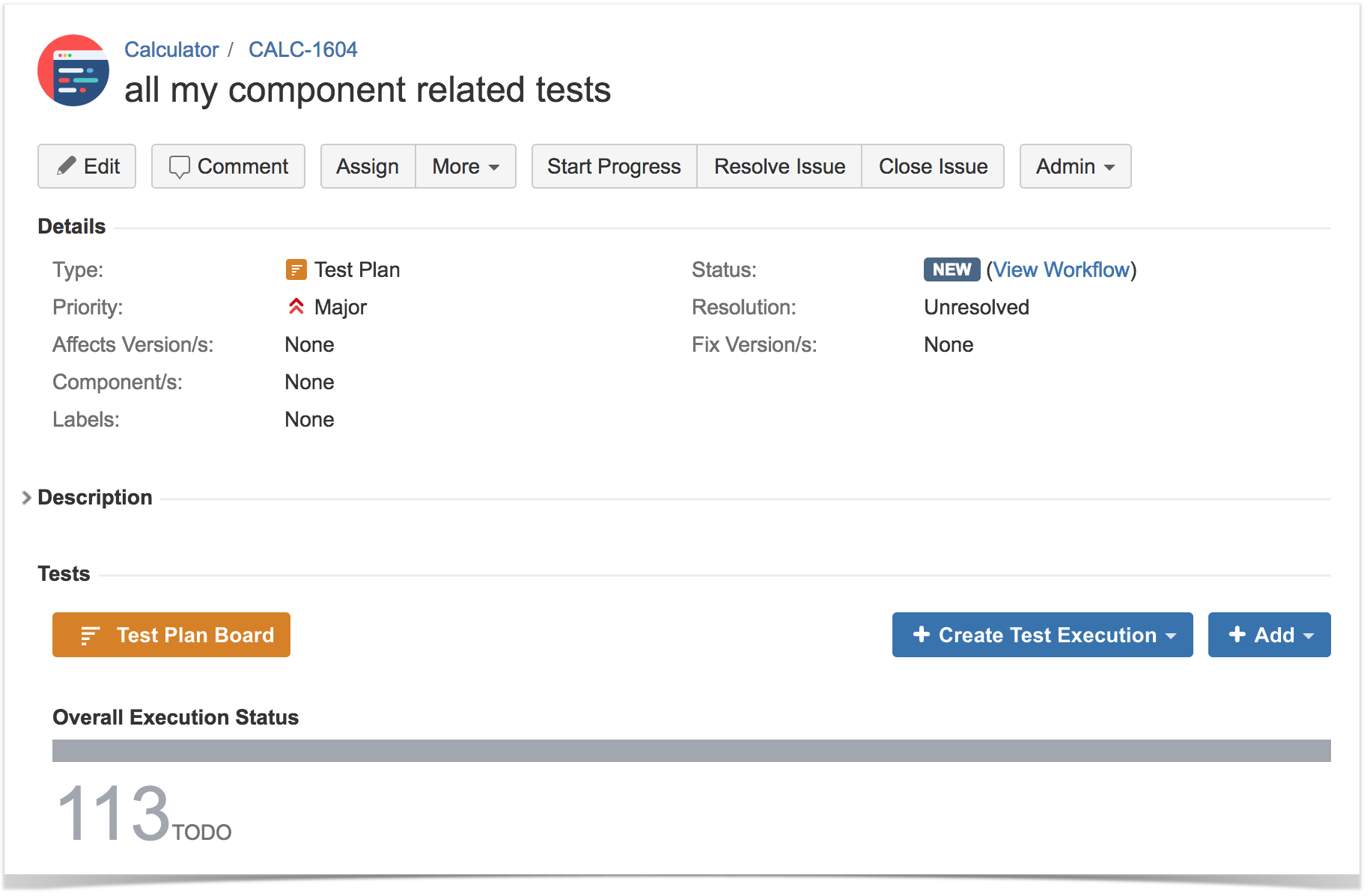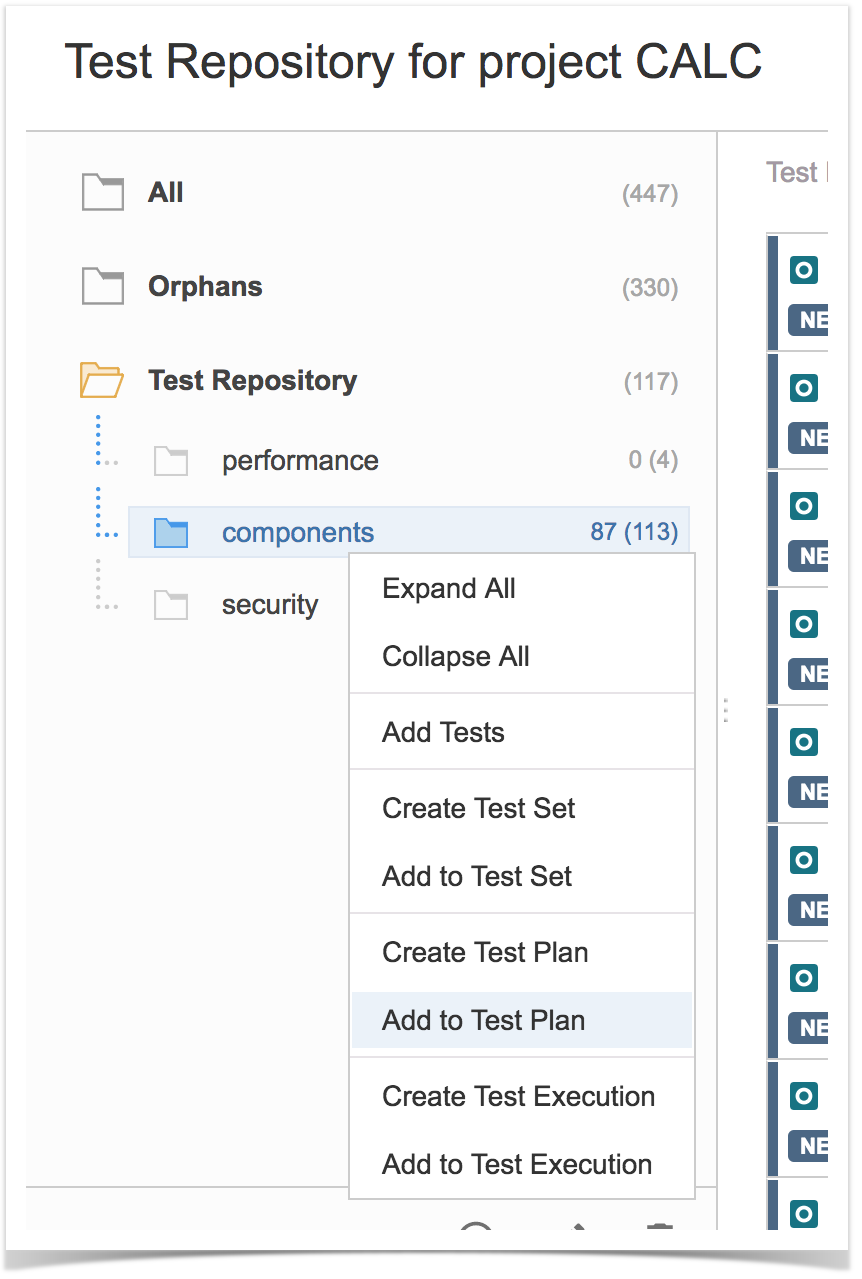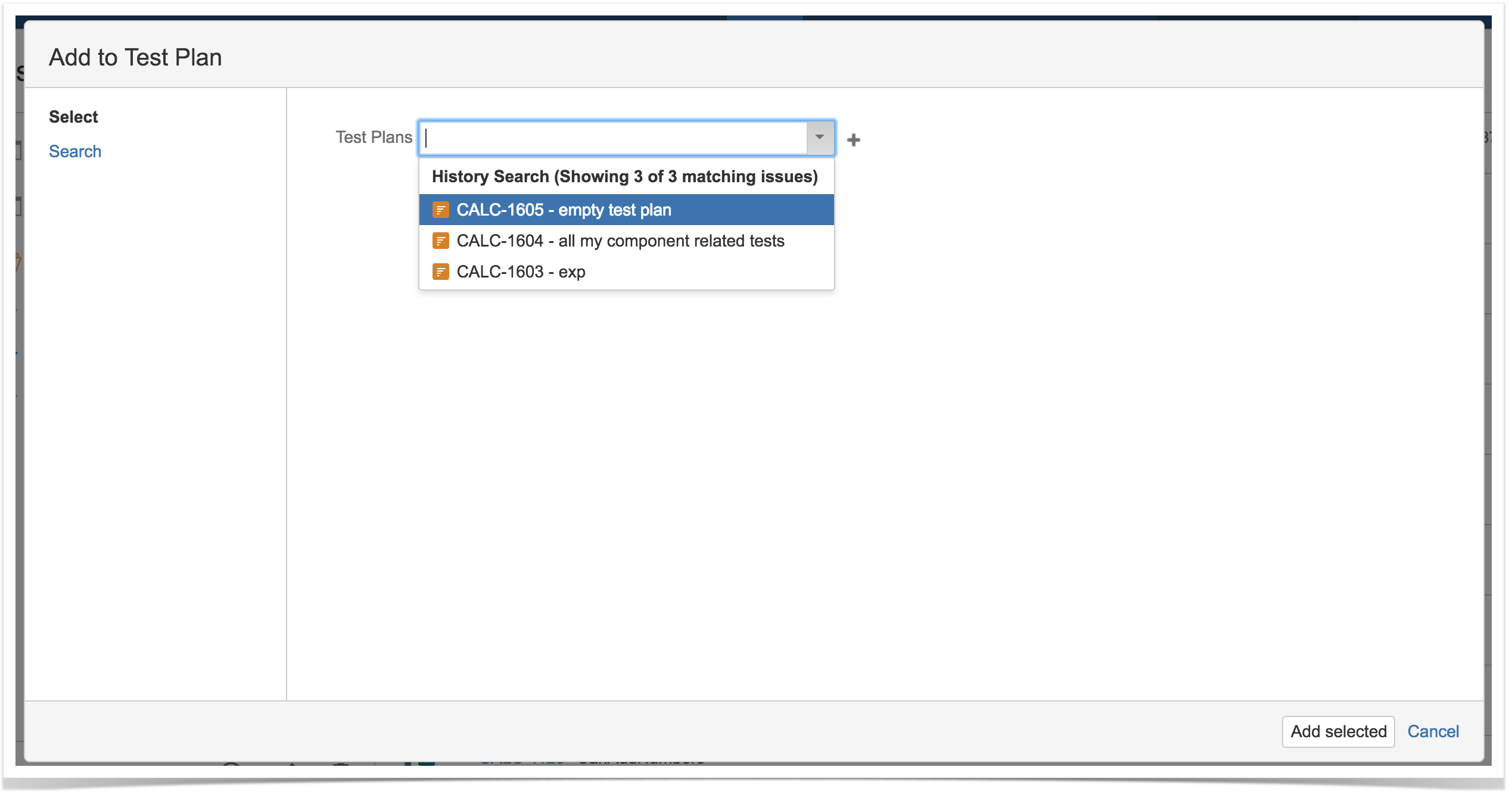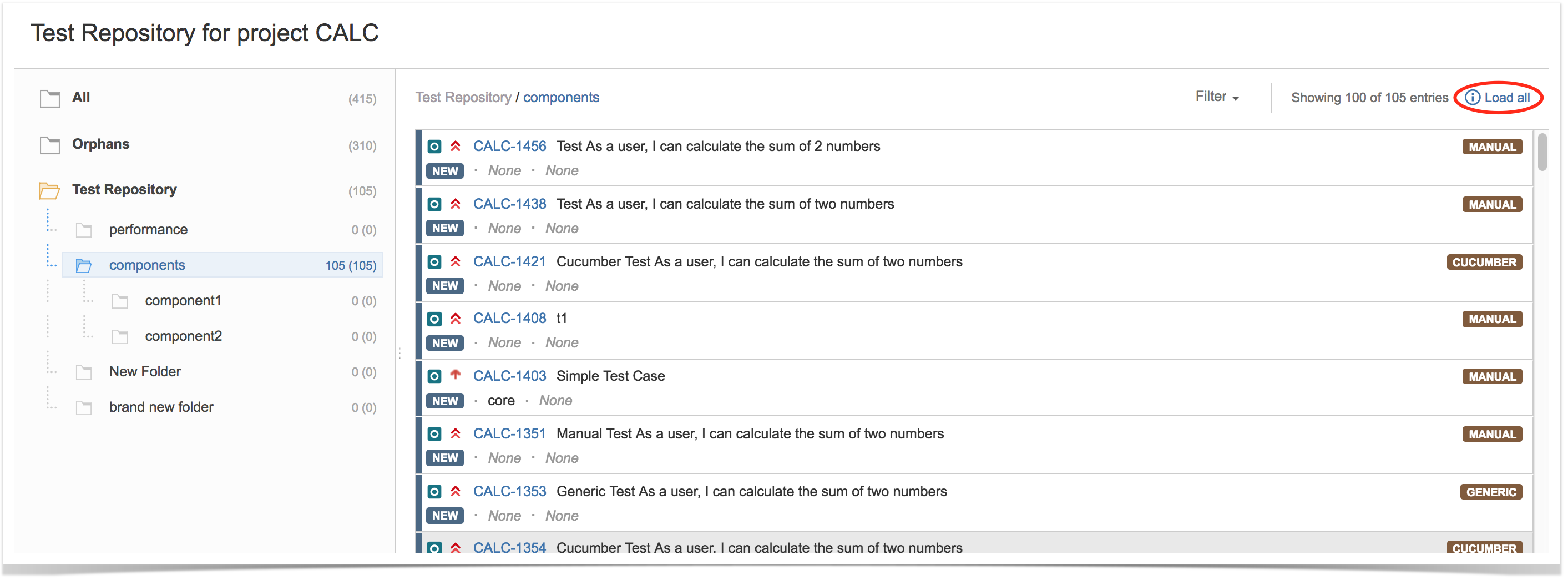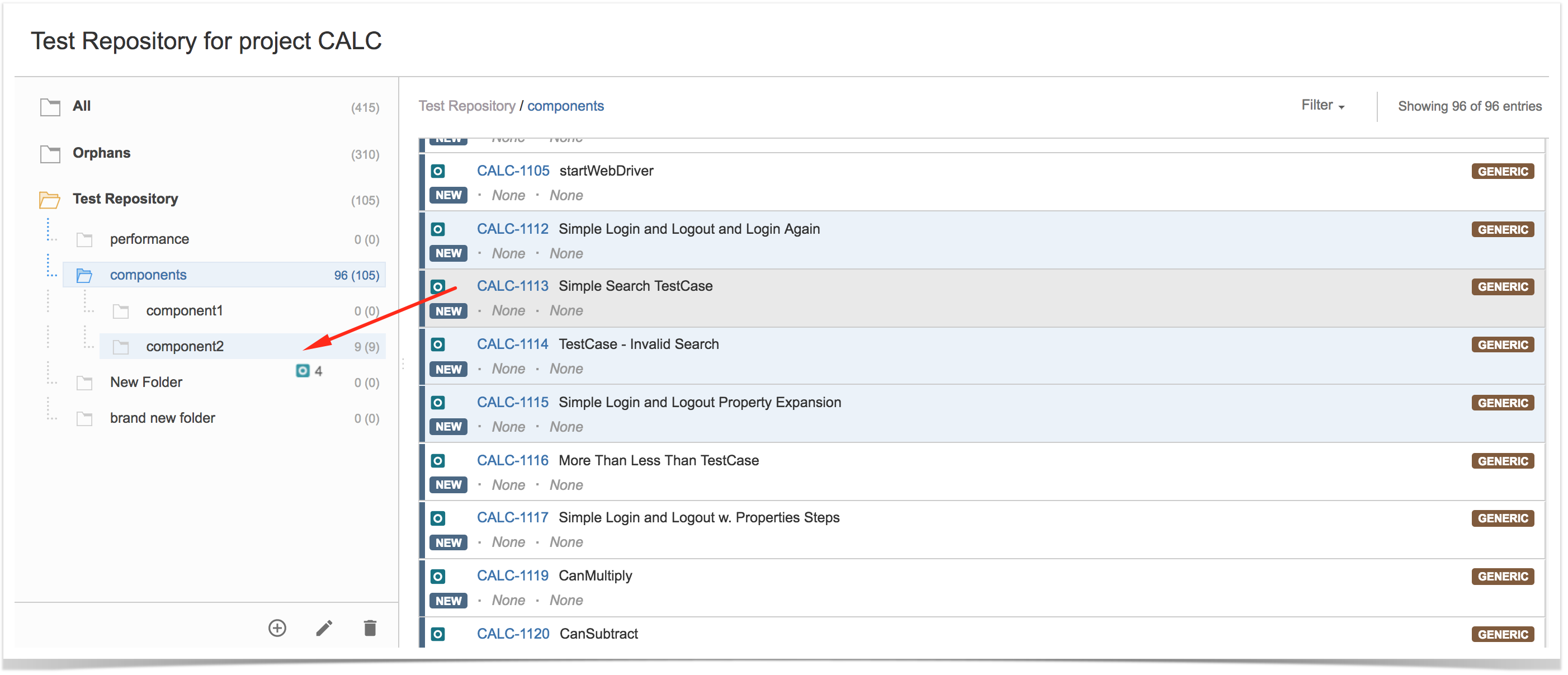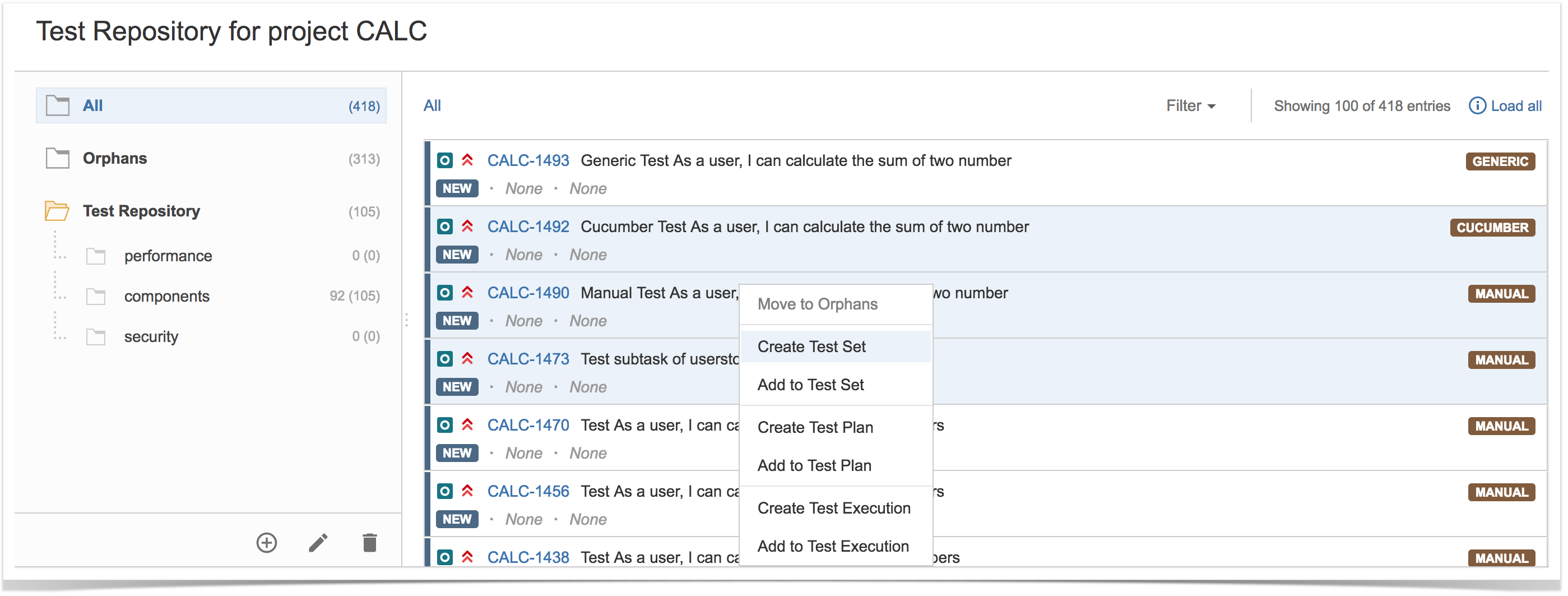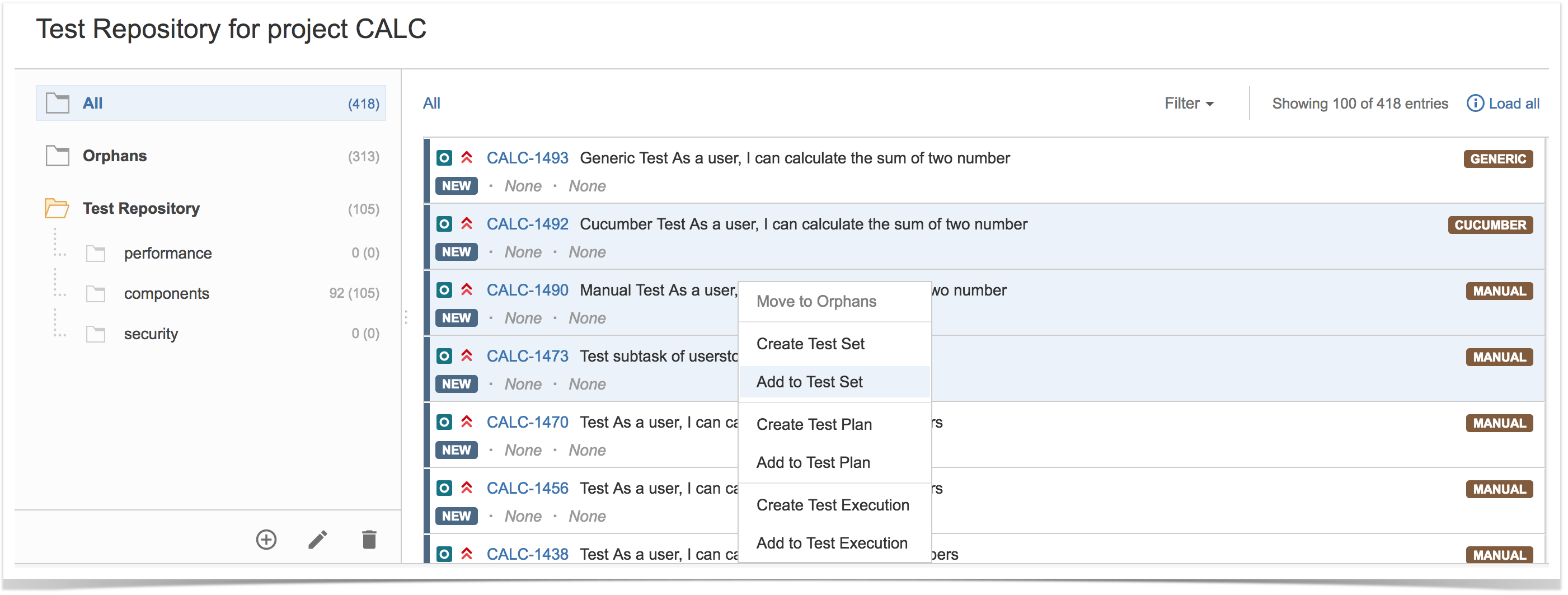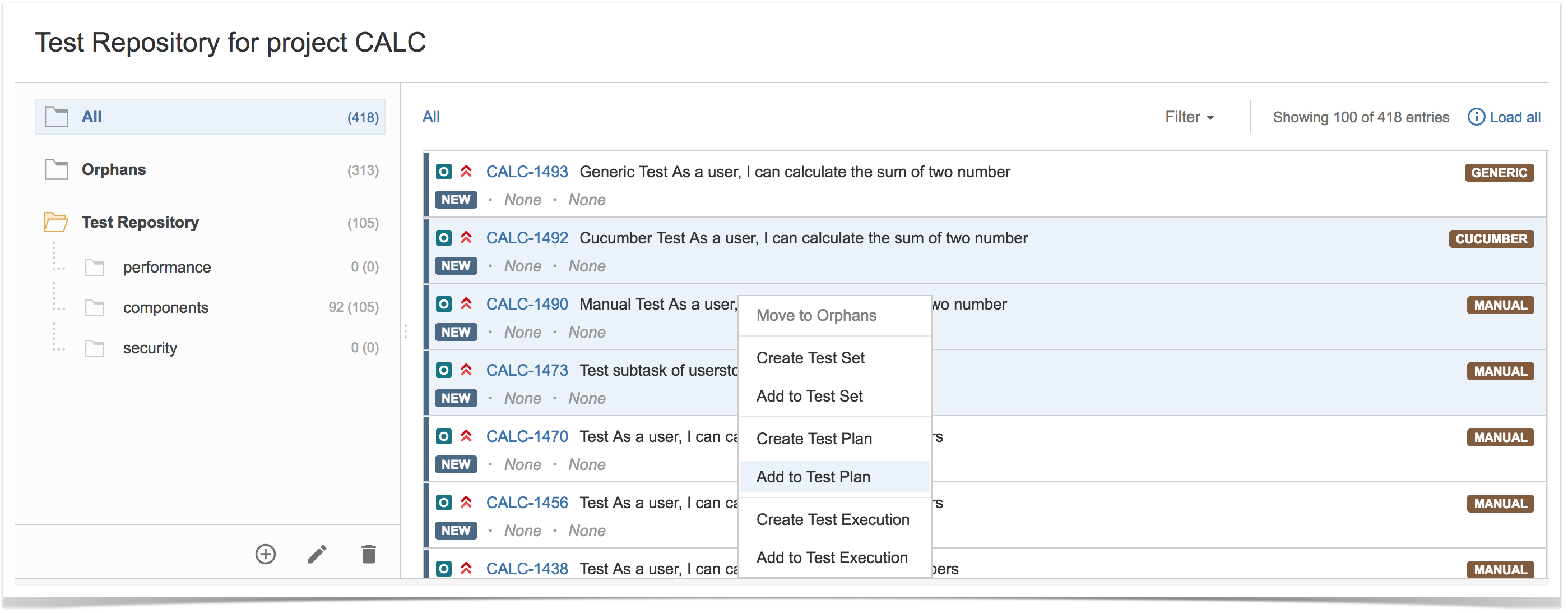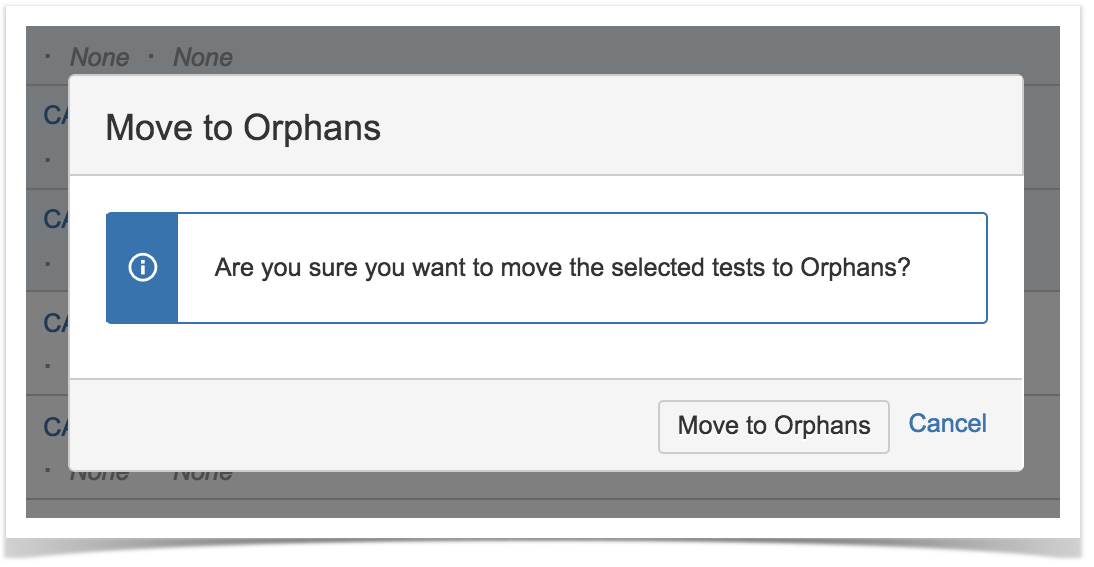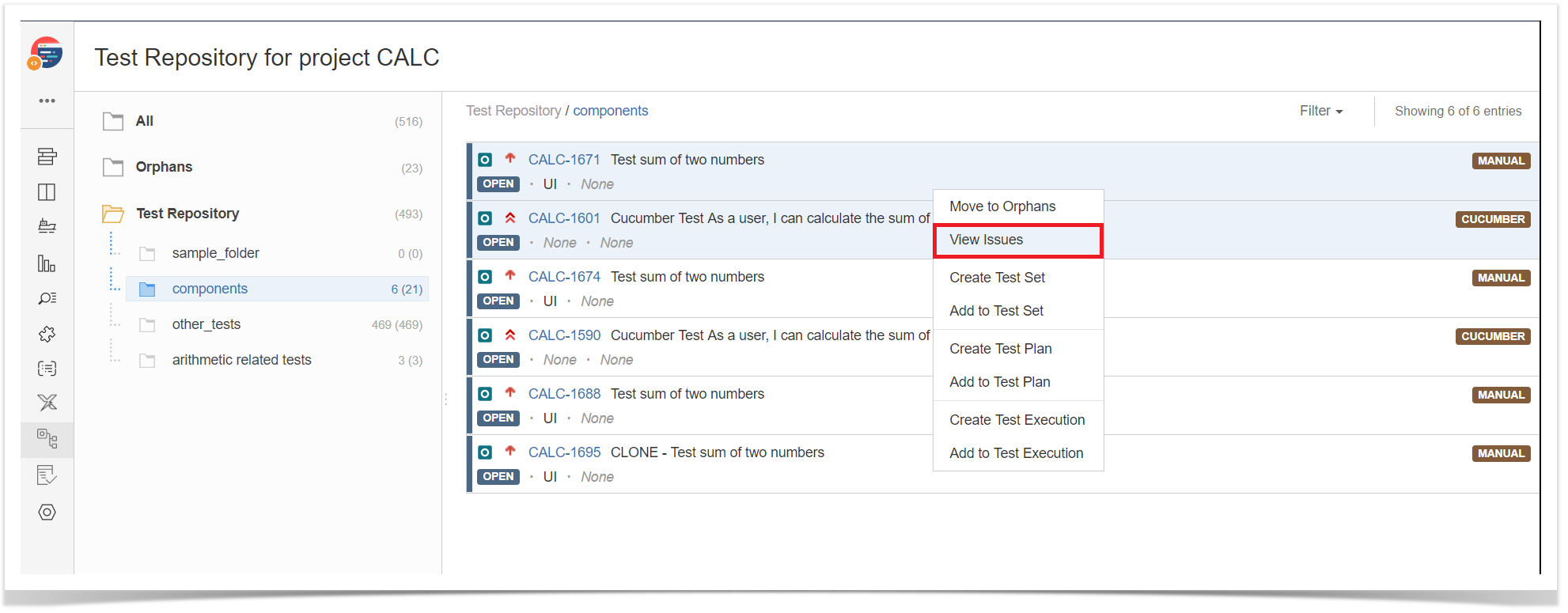Page History
The Test Repository is a project-level Test organization feature that allows users to organize Tests hierarchically via folders. Always keep in mind that each project has its own Test Repository and that a Test can only belong to one folder within the Test Repository.
| Info | ||
|---|---|---|
| ||
Please refer to theTest Repository for a more detailed information of this feature, its pros and cons, and recommendations. |
| Table of Contents |
|---|
Settings
| Info | ||
|---|---|---|
| ||
To edit the Test Repository of a given project, you must be able to, at least, access the project (i.e., browse permission), the Hierarchical Test Organization must be enabled in Xray settings, and:
Or
|
Overview of the Test Repository UI
The Test Repository screen can be accessed from the project left sidebar by choosing the Test Repository icon.
The image below depicts the several key areas of the Test Repository screen, which includes the Test Repository itself, along with some auxiliary folders.
A: Folders section
- A1: "All" and "Orphans" metafolders
- A2: the Test Repository itself, composed of folders and sub-folders with Tests organized within them
- A3: the folder Creator and CRUD actions for the current selected folder (e.g., create, rename, delete)
- A4: information about the number of Tests within the current folder and the total Tests, including sub-folders
B: Tests section
- B1: path of the folder
- B2: filter for Tests
- B3: additional information about the shown Tests versus the actual total number of Tests within the current folder
- B4: ranked list of Tests within the current folder (only direct children)
C: Switch between "flat view" and "folders view"
View Actions
You can choose between the traditional, hierarchical/folders view or a flattened view.
If you choose "Folders View" then in the Tests section (B) you will see just the Tests that are direct childs of the folder selected in the left side, within the Folders section (A). In this case you can only select Tests directly within the current selected folder.
On the other hand, if you prefer you can switch to a "Flat View"; if so, you'll see on the right side (Tests section) all the Tests that belong to that folder and related sub-folders, grouped by folder. Then you can apply a filter, if you want, select some of the Tests (no matter in which sub-folder they're in) and do an operation for them.
Folder Actions
A folder can be selected by clicking on it. Once selected, you can perform context actions or use the icons available at the bottom of the folders' section.
Note: Currently, it is not possible to select multiple folders.
Create
To create a new folder:
Step 1: Click on the parent folder.
Step 2: Click on the proper add icon at the bottom of folders section.
Step 3: Type the name for the folder.
Step 4: Press Enter or click outside of the selected folder.
Rename
To rename an existing folder:
Step 1: Double-click on the folder or click the proper edit icon at the bottom of the folders' section after selecting the folder.
Step 2: Type the new name for the folder.
Step 3: Press Enter or click outside of the selected folder.
Remove
You can easily remove an existing folder, and its descendant folders.
Tests that were in one of the removed folders will not be erased. Tests will be removed from the Test Repository, but will appear in the Orphans meta-folder, so they can be organized in the Test Repository again, if needed.
In order to remove a folder:
Step 1: Click on the parent folder.
Step 2: Click on the proper remove icon at the bottom of folders section.
Step 3: Confirm the removal of folder.
Expand/Collapse
Folders can be expanded or collapsed easily just by clicking the folder's icon.
Expand/Collapse All
Expand all and collapse all actions are available as contextual actions.
In order to expand all or collapse all the subfolders of a folder:
Step 1: Click on the parent folder.
Step 2: Use the context action Expand All or Collapse All.
View Issues
You can view the Test issues, from the selected folder and from its subfolders, in the issue search screen.
In order to view the Test issues:
Step 1: Click on the folder.
Step 2: Use the context action View Issues.
You will be redirected to the search issues page
Moving to another folder
A folder, including its descendants, can be moved to another folder just by dragging-and-dropping to the destination folder.
Dragging the folder directly on top of some existing folder will append it to the list of current child folders.
You can also move directly to a given position/rank by choosing the interim space between two existing folders.
Ordering / Ranking
A folder can be ranked within its parent folder by using drag-and-drop.
Note: If you wish to rank it as the last one (i.e., move it to the last position) within some parent folder, you just need to drag it to the parent folder.
Create Test here
You can create a Test and associate it automatically with the selected folder.
In order to create a Test in a folder,
Step 1: Click on the folder.
Step 2: Use the context action Create Test here.
Step 3: Fill out the Test fields and click Create. Your brand-new Test and associated with the selected folder.
Add Tests
You can "add" Tests to an existing folder based on some filters or JQL.
This action corresponds to "moving" them from any folder they may already be in (including the Orphans) to the destination folder. Thus, if you "add" a Test that is currently in some folder within the Test Repository to some destination folder, then it will essentially be moved from the source folder to the destination folder.
In order to add Tests to a folder,
Step 1: Click on the folder.
Step 2: Use the context action Add to Tests.
Step 3: Choose the Tests you want using the provided filters, a previously saved filter or by JQL.
Note: If you try to add non-Test issues (e.g., by using a saved filter), an error message will be displayed.
Create Test Set
You can easily create a Test Set using all the Tests in a given folder and its descendant folders.
The ranking of the Tests within the Test Set will respect the ranking they already have in the Test Repository folder.
In order to create a Test Set with all the Tests in a given folder, including its descendants:
Step 1: Click on the folder.
Step 2: Use the context action Create Test Set.
Step 3: Fill out the Test Set fields and click Create. Your brand-new Test Set is created with all the Tests, in the proper order.
Add to Test Set(s)
You can add Tests to an existing Test Set with all the Tests in a given folder and its descendant folders.
The ranking of the Tests within the Test Set will respect the ranking they already have in the Test Repository folder. If Tests already exist in the destination Test Set, then their ranking in the Test Set is not changed.
In order to add Tests from a folder, including its descendants, to some existing Test Set(s):
Step 1: Click on the folder.
Step 2: Use the context action "Add to Test Set".
Step 3: Choose the Test Set(s) key(s) and select Add selected. The Test Set(s) will now be updated.
Create Test Execution
You can easily create a Test Execution using all the Tests in a given folder and its descendant folders.
The ranking of the Tests within the Test Execution will respect the ranking they already have in the Test Repository folder.
In order to create a Test Execution with all the Tests in a given folder, including its descendants:
Step 1: Click on the folder.
Step 2: Use the context action Create Test Execution.
Step 3: Fill out the Test Execution fields and click Create. Your brand-new Test Execution is created with all the Tests, in the proper order.
Add to Test Execution(s)
You can add Tests to an existing Test Execution using all the Tests in a given folder and its descendant folders.
The ranking of the Tests within the Test Execution will respect the ranking they already have in the Test Repository folder. If Tests already exist in the destination Test Execution, then their ranking in the Test Execution is not changed.
In order to add Tests from a folder, including its descendants, to some existing Test Execution(s):
Step 1: Click on the folder.
Step 2: Use the context action Add to Test Execution.
Step 3: Choose the Test Execution(s) key(s) and select "add selected". Test Execution(s) will now be updated.
Create Test Plan
You can easily create a Test Plan using all the Tests in a given folder and its descendant folders.
The ranking of the Tests within the Test Plan will respect the ranking they already have in the Test Repository folder.
In order to create a Test Plan with all the Tests in a given folder, including its descendants:
Step 1: Click on the folder.
Step 2: Use the context action Create Test Plan.
Step 3: Decide if you want to replicate the structure, including the ascendant folders, in the Board of the destination Test Plan
Step 4: Fill out the Test Plan fields and click Create. Your brand-new Test Plan is created with all the Tests, in the proper order.
Add to Test Plan
You can add Tests to an existing Test Plan using all the Tests in a given folder and its descendant folders.
The ranking of the Tests within the Test Plan will respect the ranking they already have in the Test Repository folder.
In order to add Tests from a folder, including its descendants, to some existing Test Plan(s):
Step 1: Click on the folder.
Step 2: Use the context action Add to Test Plan.
Step 3: Decide if you want to replicate the structure, including the ascendant folders, in the Board of the destination Test Plan
Step 4: Choose the Test Plan(s) key(s) and select Add selected. Test Plan(s) will now be updated.
Tests Actions
Tests can be selected by clicking on them. Multiple selection is possible by using the "Ctrl" key (on Windows) or the "Cmd" key (on OS X). If you want to select more than one Test and the Tests are listed consecutively, use the "Shift" key to quickly select an entire group. Click the first Test in the list you want to select, hold down the "Shift" key, scroll down to the last Test you want and click it. This selects the first item, the last item and all items in between.
You can filter the list of visible Tests to make it easier to pick the Tests you need.
After selecting one or more Tests, context actions can then be done on them, such as creating a Test Set, Test Execution, etc.
Filtering visible Tests
The list of visible Tests can be filtered, so you can easily see and obtain the relevant Tests you need. Note that the filter is applied when you change to another folder.
Filtering Tests is quite useful, for example, when creating the structure of the Test Repository based on a subset of Tests from the All or Orphans meta-folders.
Moving to another folder
Tests can be moved to another folder just by dragging-and-dropping to the destination folder.
You can also use this operation for "moving" Tests (i.e., adding Tests) from the meta-folders (e.g., All, Orphans) to folders within the Test Repository.
Ordering / Ranking
Tests can be ranked within a folder by using drag-and-drop.
Create Test Set
Use the context action Create Test Set to create a new Test Set containing the selected Tests.
Add to Test Set(s)
Use the context action Add to Test Set to add selected Tests to an existing Test Set.
Create Test Execution
Use the context action Create Test Execution to create a new Test Execution containing the selected Tests.
Add to Test Execution(s)
Use the context action Add to Test Execution to add selected Tests to an existing Test Execution.
Create Test Plan
Use the context action Create Test Plan to create a new Test Plan containing the selected Tests. You will be asked if you want to recreate the folder structure in the destination Test Plan.
Add to Test Plan(s)
Use the context action Add to Test Plan to add selected Tests to an existing Test Plan. You will be asked if you want to recreate the folder structure in the destination Test Plan.
Move to Orphans
You can move Tests to the Orphans meta-folder; this is equivalent to removing them from the Test Repository.
There are 2 different ways to move Tests to the Orphans meta-folder:
First option:
Step 1: Select the Tests you want.
Step 2: Drag the Tests to the Orphans folder.
Second option:
Step 1: Select the Tests you want.
Step 2: Use the context action Move to Orphans.
Step 3: Confirm by clicking Move to Orphans.
View Issues
You can use the context action View Issues to view the selected Tests in the search issues page.
Step 1: Select the Tests you want.
Step 2: Use the context action View Issues.
How ranking works when creating, or adding Tests to, Test Sets, Test Executions and Test Plans
When creating a Test Set, Test Execution or Test Plan, or adding Tests to an existing one, Xray will respect the order of the Tests, taking into account the ranking they have in the Test Repository.
The algorithm starts by adding the Tests of the folder, respecting their rank in the folder, and then iterates through the child folders. Each child folder is processed the same way.
If a Test already exists in the destination entity (e.g., Test Set/Plan/Execution), then it is not added again and the current ranking is maintained.

